Research Proposal: Recruitment and Selection.
VerifiedAdded on 2019/09/20
|28
|6288
|438
Dissertation
AI Summary
Contribute Materials
Your contribution can guide someone’s learning journey. Share your
documents today.

Running Head: Research Proposal: Recruitment and Selection
Research Proposal
Recruitment and Selection
Research Proposal
Recruitment and Selection
Secure Best Marks with AI Grader
Need help grading? Try our AI Grader for instant feedback on your assignments.

Research Proposal: Recruitment and Selection 1
Table of Contents
Executive Summary.........................................................................................................................1
Chapter 1..........................................................................................................................................1
1.1 Introduction.......................................................................................................................1
1.2 Banking Industry of Japan................................................................................................3
1.3 Research Aims..................................................................................................................4
1.4 Research Objectives..........................................................................................................4
1.5 Research Questions...........................................................................................................4
Chapter 2 .........................................................................................................................................5
2.1 Literature Review...................................................................................................................5
Chapter 3........................................................................................................................................12
Research Type............................................................................................................................12
Sources of Data Collection and Sampling Approach.................................................................12
Research Design.........................................................................................................................13
Chapter 4........................................................................................................................................14
Data Analysis.............................................................................................................................14
Conclusion.....................................................................................................................................19
References......................................................................................................................................21
Appendices....................................................................................................................................25
Table of Contents
Executive Summary.........................................................................................................................1
Chapter 1..........................................................................................................................................1
1.1 Introduction.......................................................................................................................1
1.2 Banking Industry of Japan................................................................................................3
1.3 Research Aims..................................................................................................................4
1.4 Research Objectives..........................................................................................................4
1.5 Research Questions...........................................................................................................4
Chapter 2 .........................................................................................................................................5
2.1 Literature Review...................................................................................................................5
Chapter 3........................................................................................................................................12
Research Type............................................................................................................................12
Sources of Data Collection and Sampling Approach.................................................................12
Research Design.........................................................................................................................13
Chapter 4........................................................................................................................................14
Data Analysis.............................................................................................................................14
Conclusion.....................................................................................................................................19
References......................................................................................................................................21
Appendices....................................................................................................................................25

Research Proposal: Recruitment and Selection 2
Executive Summary
The research report mainly focuses on the recruitment and selection of international managers in
Bank of Japan. Apart of this, it also focuses on the role of HR and line managers in the design of
the company processes. In order to analyze all these things, The Bank of Japan is chosen here.
This will gives a glimpse about the banking sector in Japan and their international recruitment
and selection process. Bank of Japan is also known as the Michigan. It has its headquartered in
Chuo, Tokyo. It plays an effective role in the success of the Japan Economy. The research report
mainly serves as a guide for the academicians who are interested in performing further research
in the Banking sector. This research has been conducted by the researcher by consulted different
papers which have been written by different scholars. This has been done with the purpose of
understanding the research which has been performed previously in the similar area. In order to
conduct this study in the desired manner, a questionnaire was prepared related to the research
question and distributed to different target respondents who are the members of the Bank of
Japan. This study will help the organization and others in getting significant information about
the international recruitment and selection procedure of the Bank of Japan and roles and
responsibilities of the HR and Line staff in the formation of business processes. It also gives us
significant information about the working and growth of the Bank of Japan which helps the
researcher in preparing the research report with deeper insight.
Chapter 1
1.1 Introduction
Human resource is the most important asset of any business as no business can function without
a manual workforce. The recruitment and management of the human resource are affected by a
Executive Summary
The research report mainly focuses on the recruitment and selection of international managers in
Bank of Japan. Apart of this, it also focuses on the role of HR and line managers in the design of
the company processes. In order to analyze all these things, The Bank of Japan is chosen here.
This will gives a glimpse about the banking sector in Japan and their international recruitment
and selection process. Bank of Japan is also known as the Michigan. It has its headquartered in
Chuo, Tokyo. It plays an effective role in the success of the Japan Economy. The research report
mainly serves as a guide for the academicians who are interested in performing further research
in the Banking sector. This research has been conducted by the researcher by consulted different
papers which have been written by different scholars. This has been done with the purpose of
understanding the research which has been performed previously in the similar area. In order to
conduct this study in the desired manner, a questionnaire was prepared related to the research
question and distributed to different target respondents who are the members of the Bank of
Japan. This study will help the organization and others in getting significant information about
the international recruitment and selection procedure of the Bank of Japan and roles and
responsibilities of the HR and Line staff in the formation of business processes. It also gives us
significant information about the working and growth of the Bank of Japan which helps the
researcher in preparing the research report with deeper insight.
Chapter 1
1.1 Introduction
Human resource is the most important asset of any business as no business can function without
a manual workforce. The recruitment and management of the human resource are affected by a

Research Proposal: Recruitment and Selection 3
number of factors that include economic situation, globalization and the social and cultural
trends of the region where the company is operating. Hence the way HRM is managed
differently from country to country. Due to the rise of globalization, the scope of human resource
has changed recently. It is no more a local concept and demands for the knowledge of
international concepts and issues in order to manage the human resources efficiently. The
development of technology has made the human resource more flexible by allowing the
managers to control the situation without being physically present at work. Also, due to the rise
in the trend of labour mobility, HRM has become a wider concept. “Both demand and supply of
labour are reshaped worldwide due to globalization, creating intensified global competition
among employers and employees in the global "war for talent", and HR has to deal with this
challenge."
The rapid growth of multinational companies gave rise to the phenomenon of International
Human Resource Management. The focus of International Human Resource Management is
about the different practices in different countries so that they can manage the human resource in
the region accordingly.
Talking about the social and cultural features of Japan, it is found that the workers in Japan are
more educated, intellectual and talented than the human resource of the United Kingdom. Since
the banking industry involves direct contact with the clients and customers, there is a growing
need for qualified, courteous and customer oriented representatives. Additionally, the banking
industry is also labour intensive where there is a constant need of workforce requirement almost
24 hours. This calls for the need of flexible labour that could work different shifts including day
and night.
number of factors that include economic situation, globalization and the social and cultural
trends of the region where the company is operating. Hence the way HRM is managed
differently from country to country. Due to the rise of globalization, the scope of human resource
has changed recently. It is no more a local concept and demands for the knowledge of
international concepts and issues in order to manage the human resources efficiently. The
development of technology has made the human resource more flexible by allowing the
managers to control the situation without being physically present at work. Also, due to the rise
in the trend of labour mobility, HRM has become a wider concept. “Both demand and supply of
labour are reshaped worldwide due to globalization, creating intensified global competition
among employers and employees in the global "war for talent", and HR has to deal with this
challenge."
The rapid growth of multinational companies gave rise to the phenomenon of International
Human Resource Management. The focus of International Human Resource Management is
about the different practices in different countries so that they can manage the human resource in
the region accordingly.
Talking about the social and cultural features of Japan, it is found that the workers in Japan are
more educated, intellectual and talented than the human resource of the United Kingdom. Since
the banking industry involves direct contact with the clients and customers, there is a growing
need for qualified, courteous and customer oriented representatives. Additionally, the banking
industry is also labour intensive where there is a constant need of workforce requirement almost
24 hours. This calls for the need of flexible labour that could work different shifts including day
and night.
Paraphrase This Document
Need a fresh take? Get an instant paraphrase of this document with our AI Paraphraser
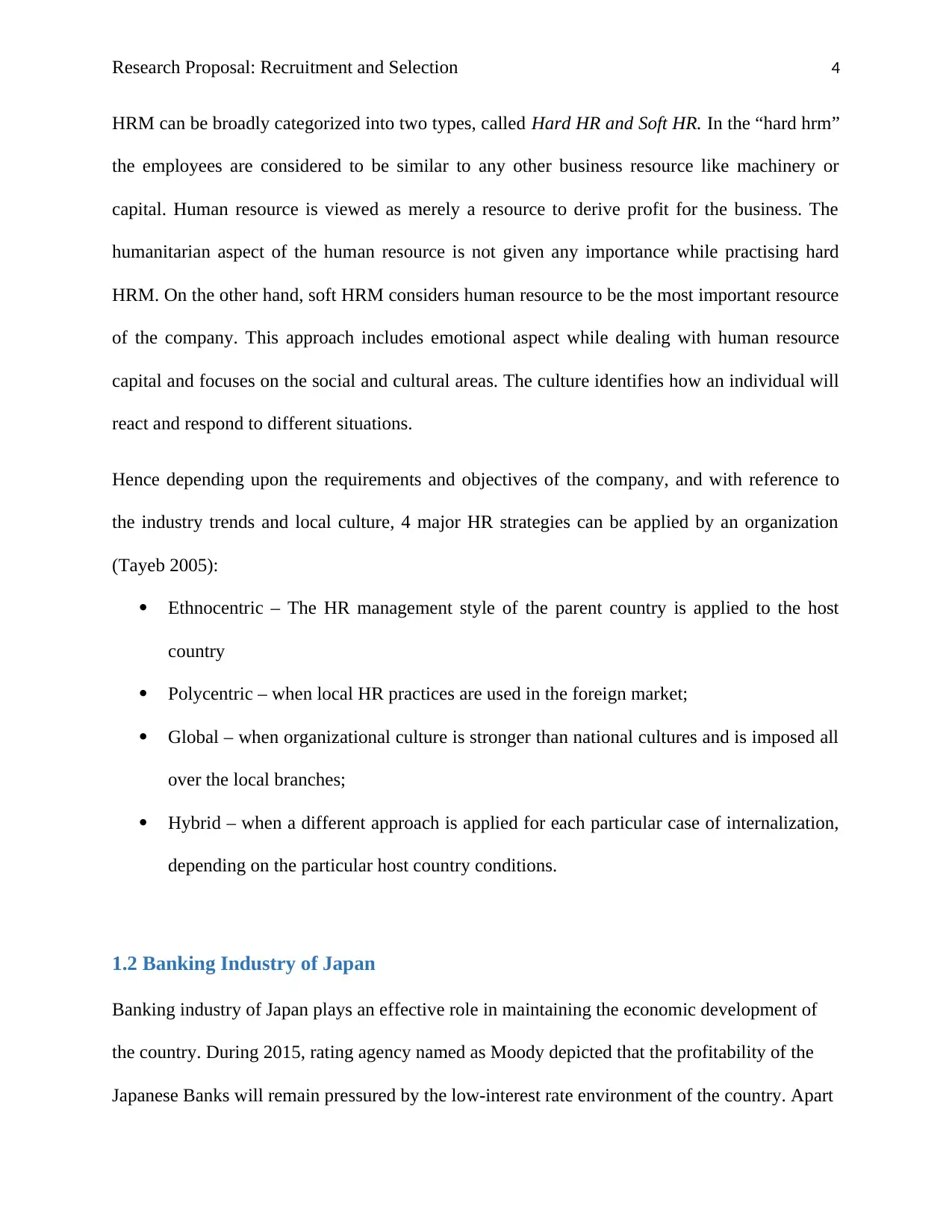
Research Proposal: Recruitment and Selection 4
HRM can be broadly categorized into two types, called Hard HR and Soft HR. In the “hard hrm”
the employees are considered to be similar to any other business resource like machinery or
capital. Human resource is viewed as merely a resource to derive profit for the business. The
humanitarian aspect of the human resource is not given any importance while practising hard
HRM. On the other hand, soft HRM considers human resource to be the most important resource
of the company. This approach includes emotional aspect while dealing with human resource
capital and focuses on the social and cultural areas. The culture identifies how an individual will
react and respond to different situations.
Hence depending upon the requirements and objectives of the company, and with reference to
the industry trends and local culture, 4 major HR strategies can be applied by an organization
(Tayeb 2005):
Ethnocentric – The HR management style of the parent country is applied to the host
country
Polycentric – when local HR practices are used in the foreign market;
Global – when organizational culture is stronger than national cultures and is imposed all
over the local branches;
Hybrid – when a different approach is applied for each particular case of internalization,
depending on the particular host country conditions.
1.2 Banking Industry of Japan
Banking industry of Japan plays an effective role in maintaining the economic development of
the country. During 2015, rating agency named as Moody depicted that the profitability of the
Japanese Banks will remain pressured by the low-interest rate environment of the country. Apart
HRM can be broadly categorized into two types, called Hard HR and Soft HR. In the “hard hrm”
the employees are considered to be similar to any other business resource like machinery or
capital. Human resource is viewed as merely a resource to derive profit for the business. The
humanitarian aspect of the human resource is not given any importance while practising hard
HRM. On the other hand, soft HRM considers human resource to be the most important resource
of the company. This approach includes emotional aspect while dealing with human resource
capital and focuses on the social and cultural areas. The culture identifies how an individual will
react and respond to different situations.
Hence depending upon the requirements and objectives of the company, and with reference to
the industry trends and local culture, 4 major HR strategies can be applied by an organization
(Tayeb 2005):
Ethnocentric – The HR management style of the parent country is applied to the host
country
Polycentric – when local HR practices are used in the foreign market;
Global – when organizational culture is stronger than national cultures and is imposed all
over the local branches;
Hybrid – when a different approach is applied for each particular case of internalization,
depending on the particular host country conditions.
1.2 Banking Industry of Japan
Banking industry of Japan plays an effective role in maintaining the economic development of
the country. During 2015, rating agency named as Moody depicted that the profitability of the
Japanese Banks will remain pressured by the low-interest rate environment of the country. Apart
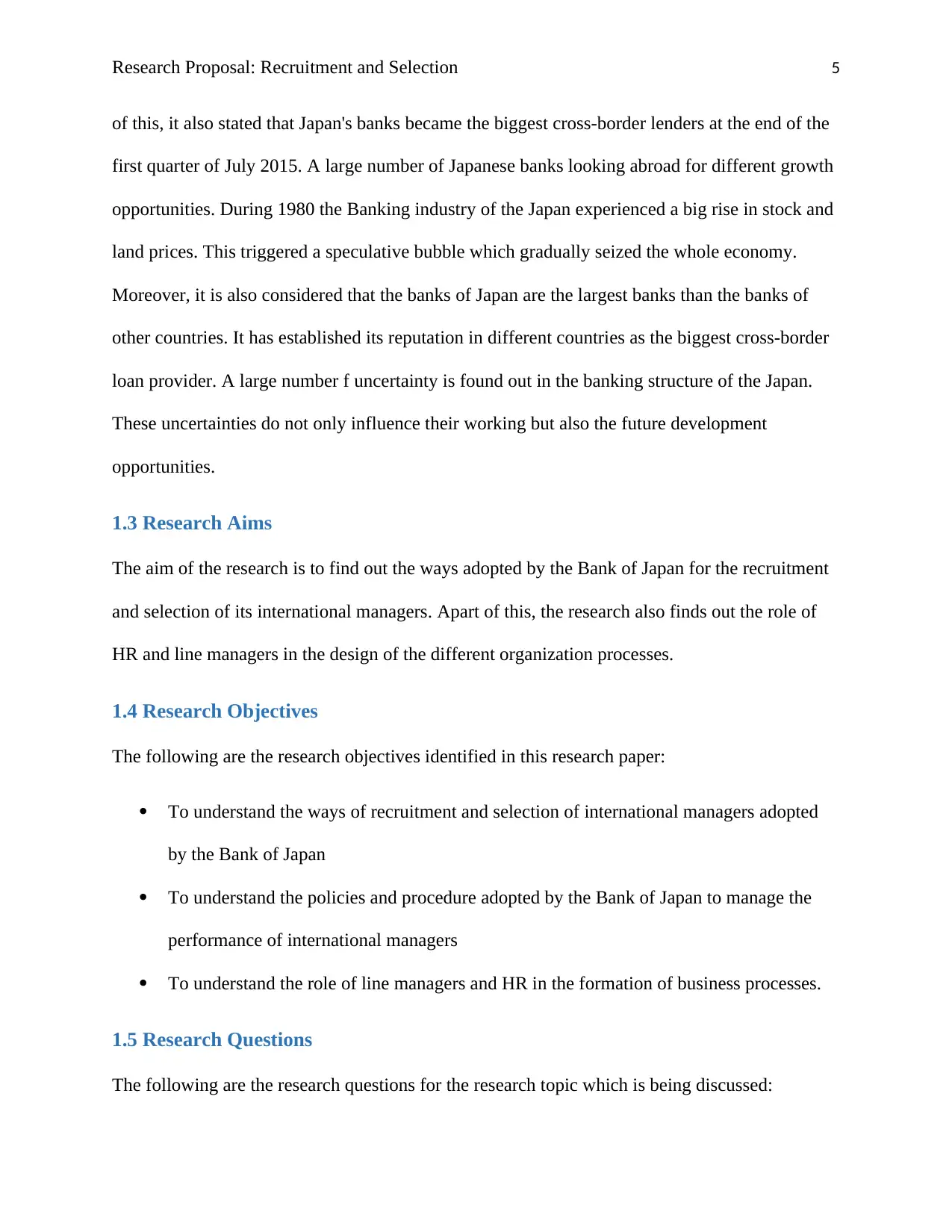
Research Proposal: Recruitment and Selection 5
of this, it also stated that Japan's banks became the biggest cross-border lenders at the end of the
first quarter of July 2015. A large number of Japanese banks looking abroad for different growth
opportunities. During 1980 the Banking industry of the Japan experienced a big rise in stock and
land prices. This triggered a speculative bubble which gradually seized the whole economy.
Moreover, it is also considered that the banks of Japan are the largest banks than the banks of
other countries. It has established its reputation in different countries as the biggest cross-border
loan provider. A large number f uncertainty is found out in the banking structure of the Japan.
These uncertainties do not only influence their working but also the future development
opportunities.
1.3 Research Aims
The aim of the research is to find out the ways adopted by the Bank of Japan for the recruitment
and selection of its international managers. Apart of this, the research also finds out the role of
HR and line managers in the design of the different organization processes.
1.4 Research Objectives
The following are the research objectives identified in this research paper:
To understand the ways of recruitment and selection of international managers adopted
by the Bank of Japan
To understand the policies and procedure adopted by the Bank of Japan to manage the
performance of international managers
To understand the role of line managers and HR in the formation of business processes.
1.5 Research Questions
The following are the research questions for the research topic which is being discussed:
of this, it also stated that Japan's banks became the biggest cross-border lenders at the end of the
first quarter of July 2015. A large number of Japanese banks looking abroad for different growth
opportunities. During 1980 the Banking industry of the Japan experienced a big rise in stock and
land prices. This triggered a speculative bubble which gradually seized the whole economy.
Moreover, it is also considered that the banks of Japan are the largest banks than the banks of
other countries. It has established its reputation in different countries as the biggest cross-border
loan provider. A large number f uncertainty is found out in the banking structure of the Japan.
These uncertainties do not only influence their working but also the future development
opportunities.
1.3 Research Aims
The aim of the research is to find out the ways adopted by the Bank of Japan for the recruitment
and selection of its international managers. Apart of this, the research also finds out the role of
HR and line managers in the design of the different organization processes.
1.4 Research Objectives
The following are the research objectives identified in this research paper:
To understand the ways of recruitment and selection of international managers adopted
by the Bank of Japan
To understand the policies and procedure adopted by the Bank of Japan to manage the
performance of international managers
To understand the role of line managers and HR in the formation of business processes.
1.5 Research Questions
The following are the research questions for the research topic which is being discussed:

Research Proposal: Recruitment and Selection 6
What is the procedure for recruitment and selection of international managers adopted by
the Bank of Japan?
What are the policies and procedures adopted by the Bank of Japan to manage the
performance of international managers?
What is the role of line managers and HR in the formation of business processes?
Chapter 2
2.1 Literature Review
Process of Recruitment and Selection of International Managers
Bank of Japan mainly recognizes for its quality staff. In order to hire its international staff, it
adopts a range of recruitment and selection process. The following is the Recruitment approach
followed by the Bank of Japan in order to compete with its international competitors and get
success in overseas projects (Anitha, 2014). Generally, it can be said that while the recruitment
of the international staff, it is the responsibility of the HR manager to measure the
competitiveness of the potential applicants at the time of selecting the recruitment process.
According to the viewpoint of Armstrong (2014) recruitment policy of the banking industry
mainly focuses on the selection of the right people with the right task at the right time, with the
desired level of specifications.
Bank of Japan mainly follows the Ethnocentric Approach in order to hire its international
personnel in the desired manner. The Bank of Japan mainly follows the ethnocentric approach in
order to give a growing opportunity to the talented candidates of its belonging nation
(Aswathappa, 2013). It means that the Bank of Singapore is mainly choosing the right candidates
from the citizens of the parent country (Singapore) to work in host nation branches. Normally,
What is the procedure for recruitment and selection of international managers adopted by
the Bank of Japan?
What are the policies and procedures adopted by the Bank of Japan to manage the
performance of international managers?
What is the role of line managers and HR in the formation of business processes?
Chapter 2
2.1 Literature Review
Process of Recruitment and Selection of International Managers
Bank of Japan mainly recognizes for its quality staff. In order to hire its international staff, it
adopts a range of recruitment and selection process. The following is the Recruitment approach
followed by the Bank of Japan in order to compete with its international competitors and get
success in overseas projects (Anitha, 2014). Generally, it can be said that while the recruitment
of the international staff, it is the responsibility of the HR manager to measure the
competitiveness of the potential applicants at the time of selecting the recruitment process.
According to the viewpoint of Armstrong (2014) recruitment policy of the banking industry
mainly focuses on the selection of the right people with the right task at the right time, with the
desired level of specifications.
Bank of Japan mainly follows the Ethnocentric Approach in order to hire its international
personnel in the desired manner. The Bank of Japan mainly follows the ethnocentric approach in
order to give a growing opportunity to the talented candidates of its belonging nation
(Aswathappa, 2013). It means that the Bank of Singapore is mainly choosing the right candidates
from the citizens of the parent country (Singapore) to work in host nation branches. Normally,
Secure Best Marks with AI Grader
Need help grading? Try our AI Grader for instant feedback on your assignments.

Research Proposal: Recruitment and Selection 7
the Bank of Japan uses this recruitment approach in order to fill the high-level foreign positions
with the expatriate employees from the parent country which is Singapore (Alfes, 2013). The
main motive of the Bank of Japan behind using the ethnocentric approach is that the staff from
the Singapore would represent the interests of its headquarters effectively and can link the
success of the organization with the parent country. In this approach, it mainly follows the
recruitment process which is a combination of six different stages (Brewster, 2016). These stages
are following:
Self-Selection: The first and the foremost step of the Bank of Japan recruitment process is self-
selection. At this stage of the recruitment process, the concerned HR department of the bank
identifies the potential candidates by using different job portals (Brewster, 2017). Apart of this,
they also use the advertisement way to attract the pool of candidates towards their potential job
openings. Applications received in the form of physical and electronic manner. Self- selection
method gives them a feeling of satisfaction to proceed with other stages.
Creation of a pool of Candidates: The second initiative of its recruitment process is the
creation of a pool of talented candidates. At this stage, the organizations make its pre-selection
and collect a pool of qualified and eligible candidates (Bryson, 2013). The received applications
analyzed on the basis of job description so that the HR department of the Bank of Japan can
come with the desired candidates with the required specializations. At this level of the
recruitment process, it uses the skills and qualities of the HR concerns in identifying the desired
candidate with the required skills (Buckingham, 2015).
Assessment of Technical Skills: Another step followed by the Bank of Japan in the recruitment
of expatriate candidate is the measurement of technical skills (Woodrow, 2014). At this level, the
technical skills of the potential or selected candidate are measured by using different assessment
the Bank of Japan uses this recruitment approach in order to fill the high-level foreign positions
with the expatriate employees from the parent country which is Singapore (Alfes, 2013). The
main motive of the Bank of Japan behind using the ethnocentric approach is that the staff from
the Singapore would represent the interests of its headquarters effectively and can link the
success of the organization with the parent country. In this approach, it mainly follows the
recruitment process which is a combination of six different stages (Brewster, 2016). These stages
are following:
Self-Selection: The first and the foremost step of the Bank of Japan recruitment process is self-
selection. At this stage of the recruitment process, the concerned HR department of the bank
identifies the potential candidates by using different job portals (Brewster, 2017). Apart of this,
they also use the advertisement way to attract the pool of candidates towards their potential job
openings. Applications received in the form of physical and electronic manner. Self- selection
method gives them a feeling of satisfaction to proceed with other stages.
Creation of a pool of Candidates: The second initiative of its recruitment process is the
creation of a pool of talented candidates. At this stage, the organizations make its pre-selection
and collect a pool of qualified and eligible candidates (Bryson, 2013). The received applications
analyzed on the basis of job description so that the HR department of the Bank of Japan can
come with the desired candidates with the required specializations. At this level of the
recruitment process, it uses the skills and qualities of the HR concerns in identifying the desired
candidate with the required skills (Buckingham, 2015).
Assessment of Technical Skills: Another step followed by the Bank of Japan in the recruitment
of expatriate candidate is the measurement of technical skills (Woodrow, 2014). At this level, the
technical skills of the potential or selected candidate are measured by using different assessment
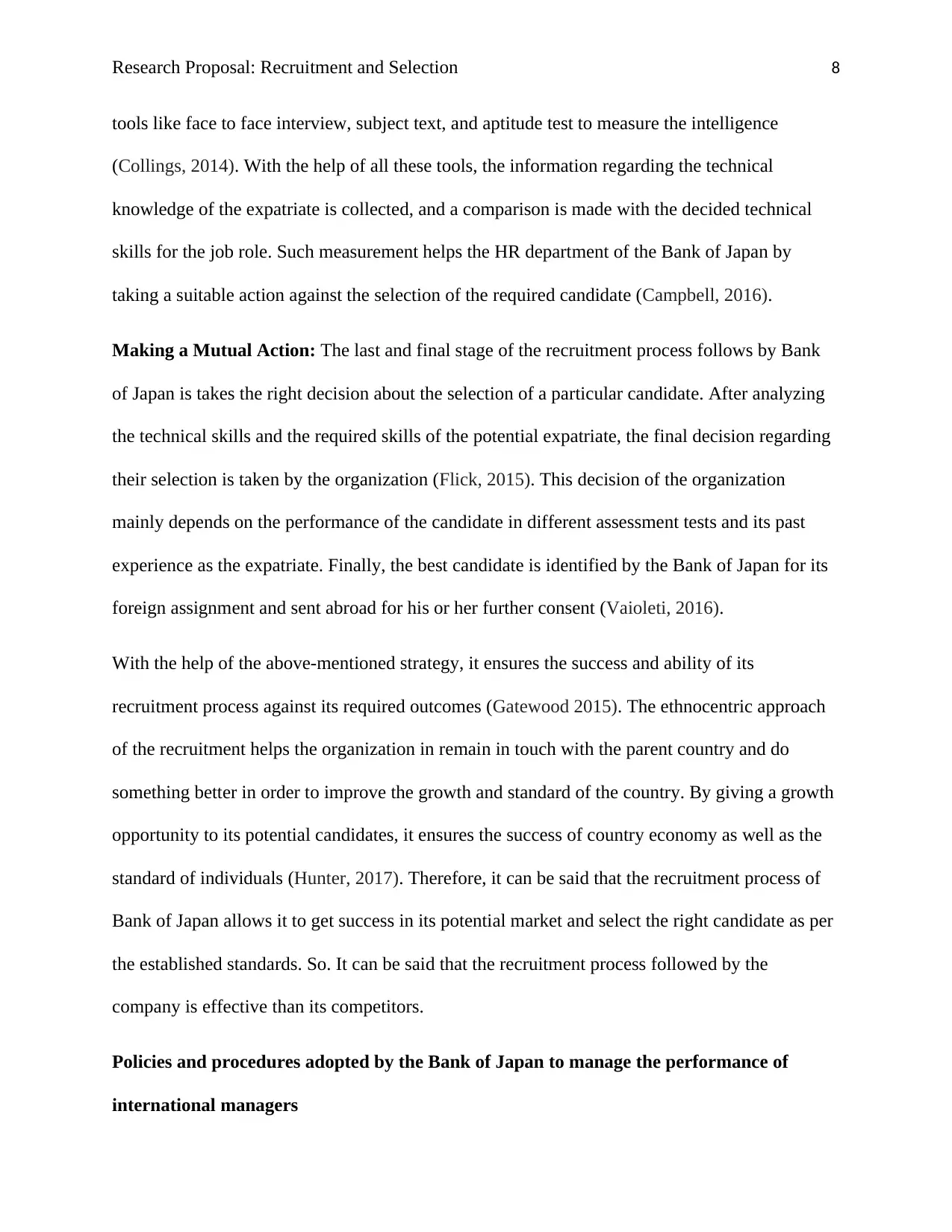
Research Proposal: Recruitment and Selection 8
tools like face to face interview, subject text, and aptitude test to measure the intelligence
(Collings, 2014). With the help of all these tools, the information regarding the technical
knowledge of the expatriate is collected, and a comparison is made with the decided technical
skills for the job role. Such measurement helps the HR department of the Bank of Japan by
taking a suitable action against the selection of the required candidate (Campbell, 2016).
Making a Mutual Action: The last and final stage of the recruitment process follows by Bank
of Japan is takes the right decision about the selection of a particular candidate. After analyzing
the technical skills and the required skills of the potential expatriate, the final decision regarding
their selection is taken by the organization (Flick, 2015). This decision of the organization
mainly depends on the performance of the candidate in different assessment tests and its past
experience as the expatriate. Finally, the best candidate is identified by the Bank of Japan for its
foreign assignment and sent abroad for his or her further consent (Vaioleti, 2016).
With the help of the above-mentioned strategy, it ensures the success and ability of its
recruitment process against its required outcomes (Gatewood 2015). The ethnocentric approach
of the recruitment helps the organization in remain in touch with the parent country and do
something better in order to improve the growth and standard of the country. By giving a growth
opportunity to its potential candidates, it ensures the success of country economy as well as the
standard of individuals (Hunter, 2017). Therefore, it can be said that the recruitment process of
Bank of Japan allows it to get success in its potential market and select the right candidate as per
the established standards. So. It can be said that the recruitment process followed by the
company is effective than its competitors.
Policies and procedures adopted by the Bank of Japan to manage the performance of
international managers
tools like face to face interview, subject text, and aptitude test to measure the intelligence
(Collings, 2014). With the help of all these tools, the information regarding the technical
knowledge of the expatriate is collected, and a comparison is made with the decided technical
skills for the job role. Such measurement helps the HR department of the Bank of Japan by
taking a suitable action against the selection of the required candidate (Campbell, 2016).
Making a Mutual Action: The last and final stage of the recruitment process follows by Bank
of Japan is takes the right decision about the selection of a particular candidate. After analyzing
the technical skills and the required skills of the potential expatriate, the final decision regarding
their selection is taken by the organization (Flick, 2015). This decision of the organization
mainly depends on the performance of the candidate in different assessment tests and its past
experience as the expatriate. Finally, the best candidate is identified by the Bank of Japan for its
foreign assignment and sent abroad for his or her further consent (Vaioleti, 2016).
With the help of the above-mentioned strategy, it ensures the success and ability of its
recruitment process against its required outcomes (Gatewood 2015). The ethnocentric approach
of the recruitment helps the organization in remain in touch with the parent country and do
something better in order to improve the growth and standard of the country. By giving a growth
opportunity to its potential candidates, it ensures the success of country economy as well as the
standard of individuals (Hunter, 2017). Therefore, it can be said that the recruitment process of
Bank of Japan allows it to get success in its potential market and select the right candidate as per
the established standards. So. It can be said that the recruitment process followed by the
company is effective than its competitors.
Policies and procedures adopted by the Bank of Japan to manage the performance of
international managers

Research Proposal: Recruitment and Selection 9
According to Kavanagh (2017) performance, manag3ement is the process of measuring the
employee's performance during the past years and take a decision regarding whether an
individual stands as far as their superiors in the same band are concerned. Bank of Japan has
formulated a large number of performance management strategies in order to maintain the
overall structure of the organization and its performance in the target market. The HR
department of the organization frames different policies regarding employee performance
management (Knies, 2015). Some of them are following:
Administrative Policy
The first and the foremost policy is administrative policy. The main motive behind the
development of the administrative policy is to formulate an effective performance management
system for employees. With the help of this system, they can easily understand the work which is
expected by the management from them and can easily receive the feedback regarding their own
performance on a timely basis (Lievens, 2015). Such information will give them significant
knowledge about their performance and their contribution towards the achievement of
organizational goals. On the other hand, it closely wants to associate its policy with the
comprehensive performance management system. Such association will help the company to
identify better and reward individuals based upon an agreed set of criteria. It can easily
understand from its statement given in the administrative policy.
"Bank of Japan strives to offer an environment where all employees will understand the
influence of their contributions to the success of organization motives and future objectives. It
will be responsible towards offering ongoing personal growth to its employees (Marchington,
2016).”
According to Kavanagh (2017) performance, manag3ement is the process of measuring the
employee's performance during the past years and take a decision regarding whether an
individual stands as far as their superiors in the same band are concerned. Bank of Japan has
formulated a large number of performance management strategies in order to maintain the
overall structure of the organization and its performance in the target market. The HR
department of the organization frames different policies regarding employee performance
management (Knies, 2015). Some of them are following:
Administrative Policy
The first and the foremost policy is administrative policy. The main motive behind the
development of the administrative policy is to formulate an effective performance management
system for employees. With the help of this system, they can easily understand the work which is
expected by the management from them and can easily receive the feedback regarding their own
performance on a timely basis (Lievens, 2015). Such information will give them significant
knowledge about their performance and their contribution towards the achievement of
organizational goals. On the other hand, it closely wants to associate its policy with the
comprehensive performance management system. Such association will help the company to
identify better and reward individuals based upon an agreed set of criteria. It can easily
understand from its statement given in the administrative policy.
"Bank of Japan strives to offer an environment where all employees will understand the
influence of their contributions to the success of organization motives and future objectives. It
will be responsible towards offering ongoing personal growth to its employees (Marchington,
2016).”
Paraphrase This Document
Need a fresh take? Get an instant paraphrase of this document with our AI Paraphraser
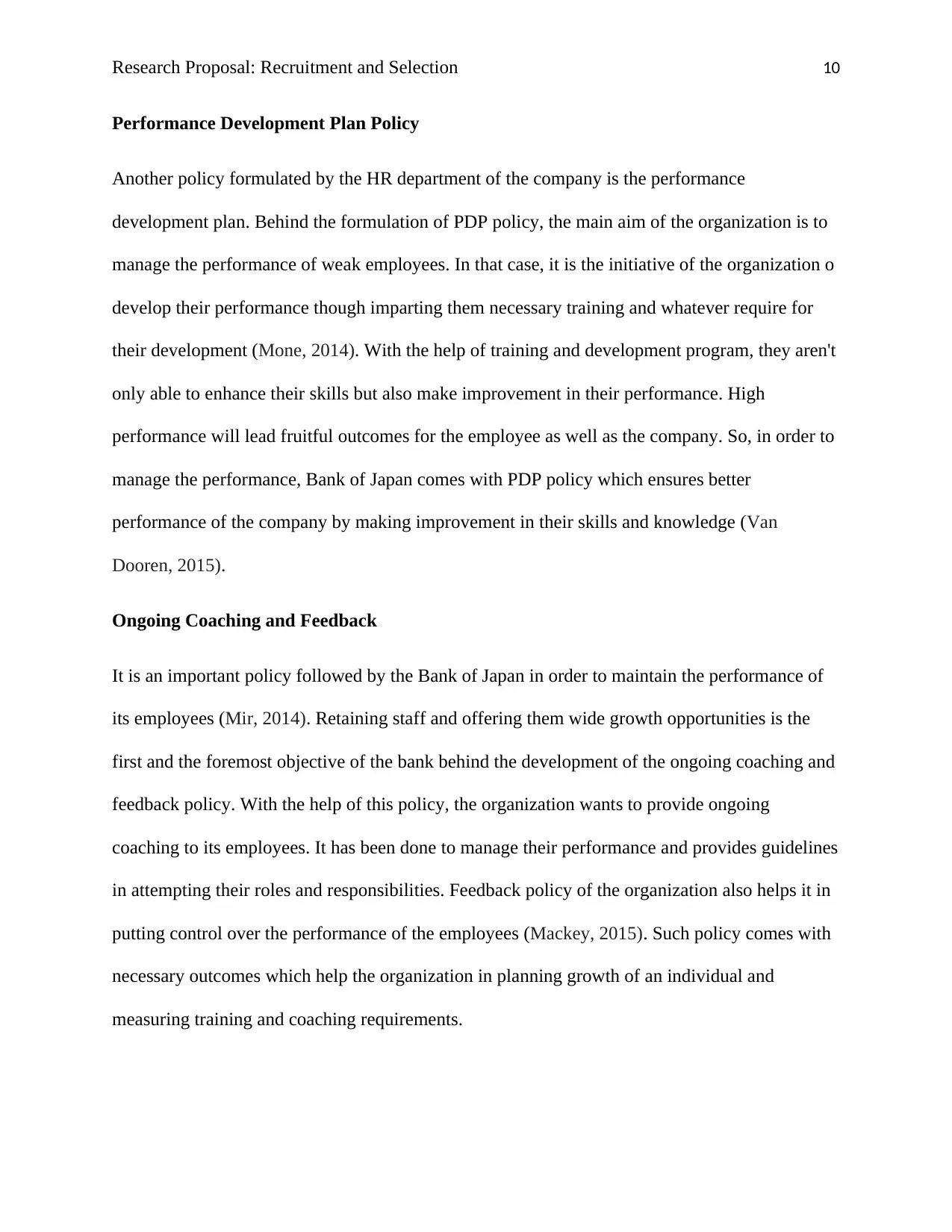
Research Proposal: Recruitment and Selection 10
Performance Development Plan Policy
Another policy formulated by the HR department of the company is the performance
development plan. Behind the formulation of PDP policy, the main aim of the organization is to
manage the performance of weak employees. In that case, it is the initiative of the organization o
develop their performance though imparting them necessary training and whatever require for
their development (Mone, 2014). With the help of training and development program, they aren't
only able to enhance their skills but also make improvement in their performance. High
performance will lead fruitful outcomes for the employee as well as the company. So, in order to
manage the performance, Bank of Japan comes with PDP policy which ensures better
performance of the company by making improvement in their skills and knowledge (Van
Dooren, 2015).
Ongoing Coaching and Feedback
It is an important policy followed by the Bank of Japan in order to maintain the performance of
its employees (Mir, 2014). Retaining staff and offering them wide growth opportunities is the
first and the foremost objective of the bank behind the development of the ongoing coaching and
feedback policy. With the help of this policy, the organization wants to provide ongoing
coaching to its employees. It has been done to manage their performance and provides guidelines
in attempting their roles and responsibilities. Feedback policy of the organization also helps it in
putting control over the performance of the employees (Mackey, 2015). Such policy comes with
necessary outcomes which help the organization in planning growth of an individual and
measuring training and coaching requirements.
Performance Development Plan Policy
Another policy formulated by the HR department of the company is the performance
development plan. Behind the formulation of PDP policy, the main aim of the organization is to
manage the performance of weak employees. In that case, it is the initiative of the organization o
develop their performance though imparting them necessary training and whatever require for
their development (Mone, 2014). With the help of training and development program, they aren't
only able to enhance their skills but also make improvement in their performance. High
performance will lead fruitful outcomes for the employee as well as the company. So, in order to
manage the performance, Bank of Japan comes with PDP policy which ensures better
performance of the company by making improvement in their skills and knowledge (Van
Dooren, 2015).
Ongoing Coaching and Feedback
It is an important policy followed by the Bank of Japan in order to maintain the performance of
its employees (Mir, 2014). Retaining staff and offering them wide growth opportunities is the
first and the foremost objective of the bank behind the development of the ongoing coaching and
feedback policy. With the help of this policy, the organization wants to provide ongoing
coaching to its employees. It has been done to manage their performance and provides guidelines
in attempting their roles and responsibilities. Feedback policy of the organization also helps it in
putting control over the performance of the employees (Mackey, 2015). Such policy comes with
necessary outcomes which help the organization in planning growth of an individual and
measuring training and coaching requirements.
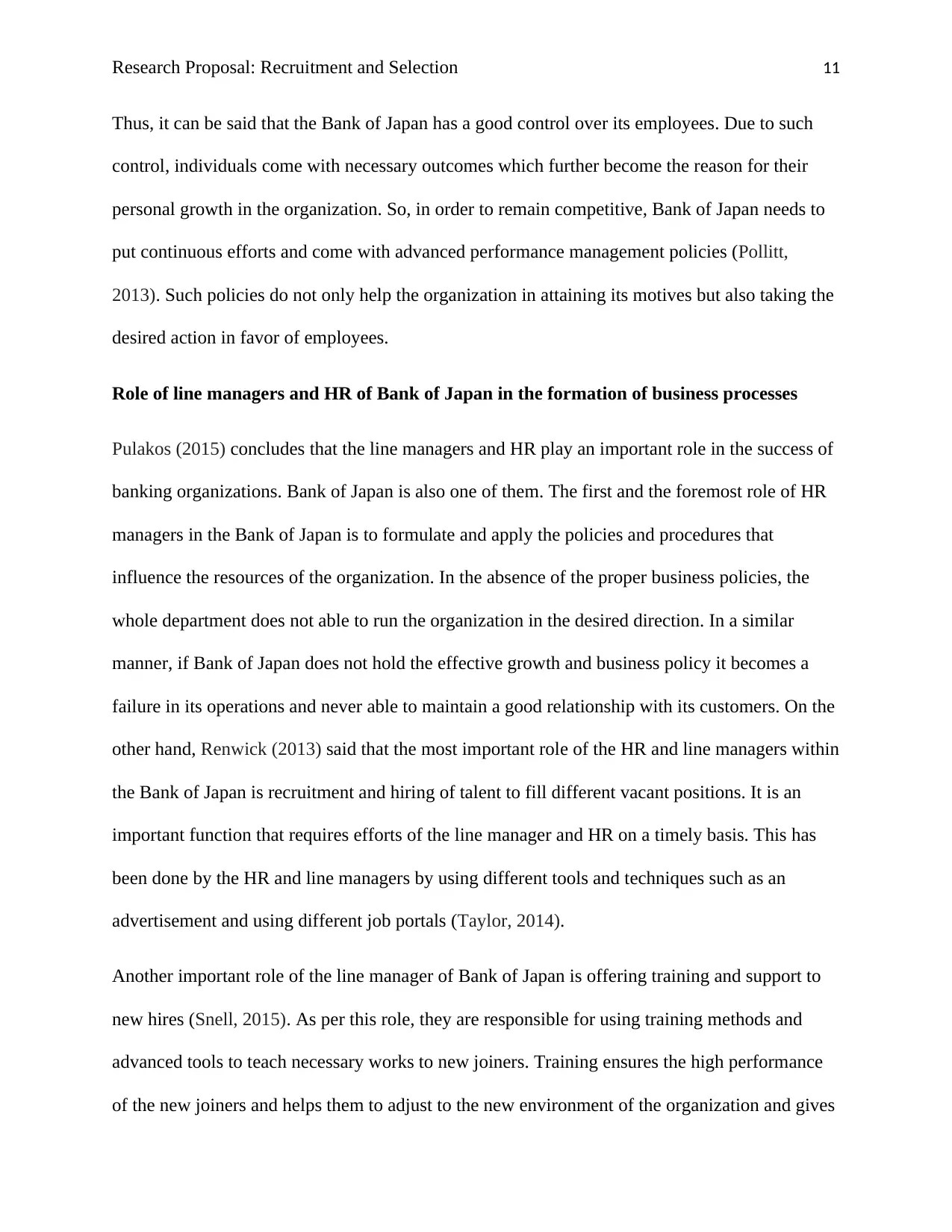
Research Proposal: Recruitment and Selection 11
Thus, it can be said that the Bank of Japan has a good control over its employees. Due to such
control, individuals come with necessary outcomes which further become the reason for their
personal growth in the organization. So, in order to remain competitive, Bank of Japan needs to
put continuous efforts and come with advanced performance management policies (Pollitt,
2013). Such policies do not only help the organization in attaining its motives but also taking the
desired action in favor of employees.
Role of line managers and HR of Bank of Japan in the formation of business processes
Pulakos (2015) concludes that the line managers and HR play an important role in the success of
banking organizations. Bank of Japan is also one of them. The first and the foremost role of HR
managers in the Bank of Japan is to formulate and apply the policies and procedures that
influence the resources of the organization. In the absence of the proper business policies, the
whole department does not able to run the organization in the desired direction. In a similar
manner, if Bank of Japan does not hold the effective growth and business policy it becomes a
failure in its operations and never able to maintain a good relationship with its customers. On the
other hand, Renwick (2013) said that the most important role of the HR and line managers within
the Bank of Japan is recruitment and hiring of talent to fill different vacant positions. It is an
important function that requires efforts of the line manager and HR on a timely basis. This has
been done by the HR and line managers by using different tools and techniques such as an
advertisement and using different job portals (Taylor, 2014).
Another important role of the line manager of Bank of Japan is offering training and support to
new hires (Snell, 2015). As per this role, they are responsible for using training methods and
advanced tools to teach necessary works to new joiners. Training ensures the high performance
of the new joiners and helps them to adjust to the new environment of the organization and gives
Thus, it can be said that the Bank of Japan has a good control over its employees. Due to such
control, individuals come with necessary outcomes which further become the reason for their
personal growth in the organization. So, in order to remain competitive, Bank of Japan needs to
put continuous efforts and come with advanced performance management policies (Pollitt,
2013). Such policies do not only help the organization in attaining its motives but also taking the
desired action in favor of employees.
Role of line managers and HR of Bank of Japan in the formation of business processes
Pulakos (2015) concludes that the line managers and HR play an important role in the success of
banking organizations. Bank of Japan is also one of them. The first and the foremost role of HR
managers in the Bank of Japan is to formulate and apply the policies and procedures that
influence the resources of the organization. In the absence of the proper business policies, the
whole department does not able to run the organization in the desired direction. In a similar
manner, if Bank of Japan does not hold the effective growth and business policy it becomes a
failure in its operations and never able to maintain a good relationship with its customers. On the
other hand, Renwick (2013) said that the most important role of the HR and line managers within
the Bank of Japan is recruitment and hiring of talent to fill different vacant positions. It is an
important function that requires efforts of the line manager and HR on a timely basis. This has
been done by the HR and line managers by using different tools and techniques such as an
advertisement and using different job portals (Taylor, 2014).
Another important role of the line manager of Bank of Japan is offering training and support to
new hires (Snell, 2015). As per this role, they are responsible for using training methods and
advanced tools to teach necessary works to new joiners. Training ensures the high performance
of the new joiners and helps them to adjust to the new environment of the organization and gives

Research Proposal: Recruitment and Selection 12
their best. Furthermore, line manager of Bank of Japan also responsible for the cross-training of
employees. This is due to ensure job rotation and minimize the gap of assignment coverage
(Southall, 2014). Such functions of the line managers and HR help them to remain the important
part of the organization and contribute well towards its success. The line manager and HR think
that the growth of individual employees as well as the organization as an entire (Smith, 2015).
On the other hand, it can be said that the line managers and HR department of Bank of Japan
remain liable towards the management of recruitment, performance management, training,
leadership development, legal complaint processes, compensation and benefits management
(Sikora, 2015). The efficiency of the line managers and HR department in performing these
functions ensures a positive effect on the productivity of the organization and permits higher
funds and growth opportunities for employees. Such effort of the line managers and HR will
ensure the efficiency of their assigned roles and responsibilities and achieve overall success.
For example, Mizuho Bank is an effective bank of the Japan, and its HR functions are in charge
of the processes that allow them to remain competitive in its target market (Seuring, 2013). In a
similar manner, HR and line managers ensure the great success of the Bank of Japan by adding
new features in the working of the organization. The main idea of the human resource
management contributes to Bank of Japan effectiveness in administering the different functions
of personnel department over the amount of people and makes everyone in charge for lessening
and something the costs (Shields, 2015). Furthermore, line managers and HR department of the
Bank of Japan is responsible for make plan, regulate, and control the working of the organization
so that result can turn into required side of the organization (Shackleton, 2015). Therefore, it can
be said that the line managers and HR play an effective role in the success of Bank of Japan. It is
their best. Furthermore, line manager of Bank of Japan also responsible for the cross-training of
employees. This is due to ensure job rotation and minimize the gap of assignment coverage
(Southall, 2014). Such functions of the line managers and HR help them to remain the important
part of the organization and contribute well towards its success. The line manager and HR think
that the growth of individual employees as well as the organization as an entire (Smith, 2015).
On the other hand, it can be said that the line managers and HR department of Bank of Japan
remain liable towards the management of recruitment, performance management, training,
leadership development, legal complaint processes, compensation and benefits management
(Sikora, 2015). The efficiency of the line managers and HR department in performing these
functions ensures a positive effect on the productivity of the organization and permits higher
funds and growth opportunities for employees. Such effort of the line managers and HR will
ensure the efficiency of their assigned roles and responsibilities and achieve overall success.
For example, Mizuho Bank is an effective bank of the Japan, and its HR functions are in charge
of the processes that allow them to remain competitive in its target market (Seuring, 2013). In a
similar manner, HR and line managers ensure the great success of the Bank of Japan by adding
new features in the working of the organization. The main idea of the human resource
management contributes to Bank of Japan effectiveness in administering the different functions
of personnel department over the amount of people and makes everyone in charge for lessening
and something the costs (Shields, 2015). Furthermore, line managers and HR department of the
Bank of Japan is responsible for make plan, regulate, and control the working of the organization
so that result can turn into required side of the organization (Shackleton, 2015). Therefore, it can
be said that the line managers and HR play an effective role in the success of Bank of Japan. It is
Secure Best Marks with AI Grader
Need help grading? Try our AI Grader for instant feedback on your assignments.

Research Proposal: Recruitment and Selection 13
recognized for its good banking schemes and management operations. This becomes possible
only due to the good efforts of the line managers and HR of Bank of Japan (Sheehan, 2014).
Chapter 3
Research Type
Generally, it can be said that the type of research is descriptive here. The research is a
combination of different research questions which further analyzed by using the target number of
population. The responses collected from these questions are further analyzed in a significant
manner. Descriptive analysis proves helpful in analyzing what is going on present days or in
variable context (Flick, 2015). Furthermore, it is described that the descriptive type of research is
selected due to a natural research environment that is not linked to any internal or external
change. On the other hand, it can be said that the necessary information is collected by using
different forms and represented in the paper for analysis purpose. Moreover, it can be said that
the research is descriptive because the data analysis is an essential part of the project. Apart of
this, it also has some quantitative measures that prove helpful in the descriptive analysis of the
project.
Sources of Data Collection and Sampling Approach
The research is a combination of different sources. It is because the data is required to perform
efficient analysis in the desired manner. All these sources are used to evaluate the role of Bank of
Japan line managers and HR, policies and procedures, or recruitment structure. The research
used both the secondary as well as the primary resources for the data collection. The primary
sources that have been used in the research are following:
recognized for its good banking schemes and management operations. This becomes possible
only due to the good efforts of the line managers and HR of Bank of Japan (Sheehan, 2014).
Chapter 3
Research Type
Generally, it can be said that the type of research is descriptive here. The research is a
combination of different research questions which further analyzed by using the target number of
population. The responses collected from these questions are further analyzed in a significant
manner. Descriptive analysis proves helpful in analyzing what is going on present days or in
variable context (Flick, 2015). Furthermore, it is described that the descriptive type of research is
selected due to a natural research environment that is not linked to any internal or external
change. On the other hand, it can be said that the necessary information is collected by using
different forms and represented in the paper for analysis purpose. Moreover, it can be said that
the research is descriptive because the data analysis is an essential part of the project. Apart of
this, it also has some quantitative measures that prove helpful in the descriptive analysis of the
project.
Sources of Data Collection and Sampling Approach
The research is a combination of different sources. It is because the data is required to perform
efficient analysis in the desired manner. All these sources are used to evaluate the role of Bank of
Japan line managers and HR, policies and procedures, or recruitment structure. The research
used both the secondary as well as the primary resources for the data collection. The primary
sources that have been used in the research are following:
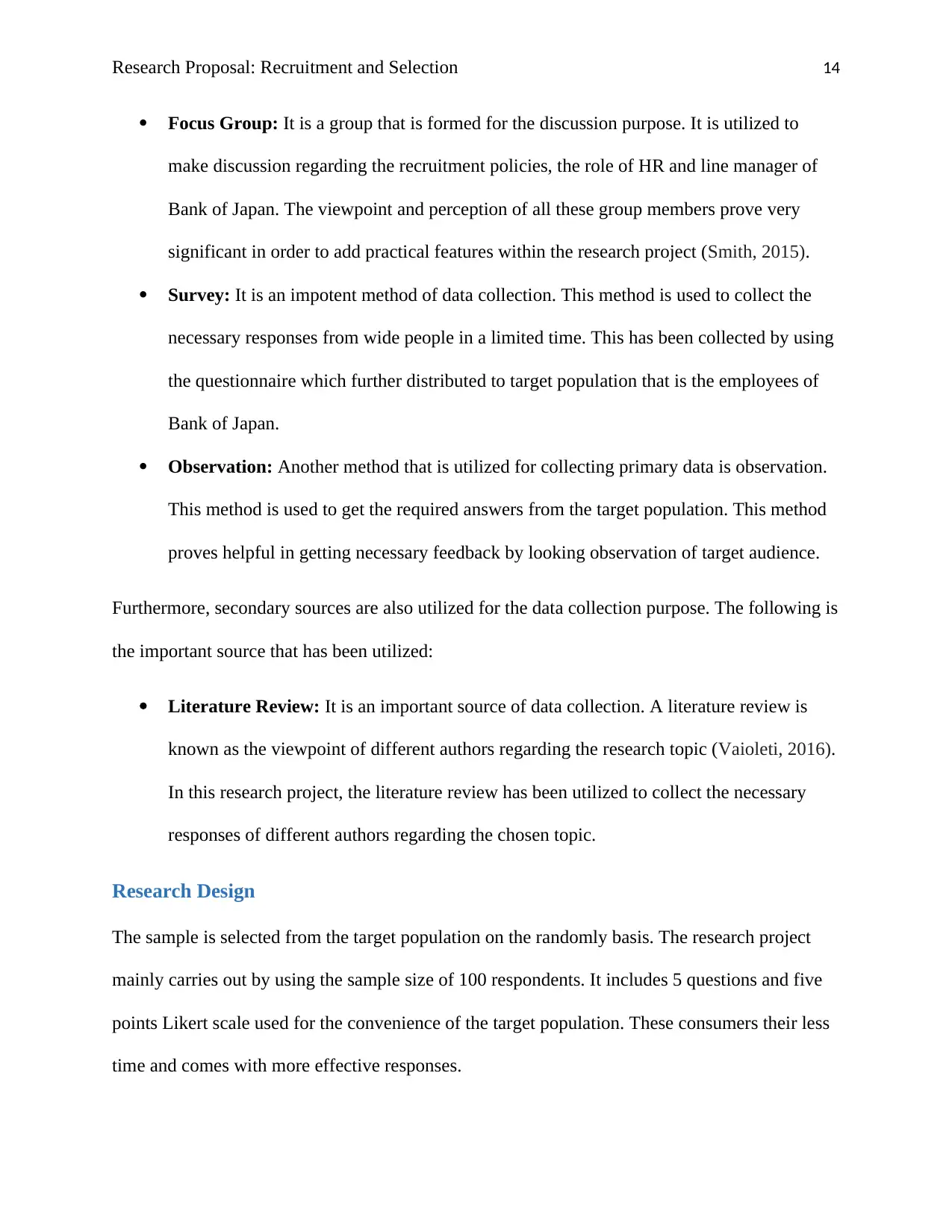
Research Proposal: Recruitment and Selection 14
Focus Group: It is a group that is formed for the discussion purpose. It is utilized to
make discussion regarding the recruitment policies, the role of HR and line manager of
Bank of Japan. The viewpoint and perception of all these group members prove very
significant in order to add practical features within the research project (Smith, 2015).
Survey: It is an impotent method of data collection. This method is used to collect the
necessary responses from wide people in a limited time. This has been collected by using
the questionnaire which further distributed to target population that is the employees of
Bank of Japan.
Observation: Another method that is utilized for collecting primary data is observation.
This method is used to get the required answers from the target population. This method
proves helpful in getting necessary feedback by looking observation of target audience.
Furthermore, secondary sources are also utilized for the data collection purpose. The following is
the important source that has been utilized:
Literature Review: It is an important source of data collection. A literature review is
known as the viewpoint of different authors regarding the research topic (Vaioleti, 2016).
In this research project, the literature review has been utilized to collect the necessary
responses of different authors regarding the chosen topic.
Research Design
The sample is selected from the target population on the randomly basis. The research project
mainly carries out by using the sample size of 100 respondents. It includes 5 questions and five
points Likert scale used for the convenience of the target population. These consumers their less
time and comes with more effective responses.
Focus Group: It is a group that is formed for the discussion purpose. It is utilized to
make discussion regarding the recruitment policies, the role of HR and line manager of
Bank of Japan. The viewpoint and perception of all these group members prove very
significant in order to add practical features within the research project (Smith, 2015).
Survey: It is an impotent method of data collection. This method is used to collect the
necessary responses from wide people in a limited time. This has been collected by using
the questionnaire which further distributed to target population that is the employees of
Bank of Japan.
Observation: Another method that is utilized for collecting primary data is observation.
This method is used to get the required answers from the target population. This method
proves helpful in getting necessary feedback by looking observation of target audience.
Furthermore, secondary sources are also utilized for the data collection purpose. The following is
the important source that has been utilized:
Literature Review: It is an important source of data collection. A literature review is
known as the viewpoint of different authors regarding the research topic (Vaioleti, 2016).
In this research project, the literature review has been utilized to collect the necessary
responses of different authors regarding the chosen topic.
Research Design
The sample is selected from the target population on the randomly basis. The research project
mainly carries out by using the sample size of 100 respondents. It includes 5 questions and five
points Likert scale used for the convenience of the target population. These consumers their less
time and comes with more effective responses.

Research Proposal: Recruitment and Selection 15
Chapter 4
Data Analysis
This section mainly describes the results of the research that have been evaluated by using the
advanced software known as MS excel. It is used due to its efficiency in data analysis than
others.
Question 1: What is your current designation in the organization?
Designation Number of Respondents
Top-level 50
Bottom level 20
Managerial level 30
On the basis of above analysis, it can be concluded that the top level employees are greater than
the other two levels. It is due to more involvement of top level employees towards HR activities.
The number of top level respondents is 50 and others are 30 or 20.
Chapter 4
Data Analysis
This section mainly describes the results of the research that have been evaluated by using the
advanced software known as MS excel. It is used due to its efficiency in data analysis than
others.
Question 1: What is your current designation in the organization?
Designation Number of Respondents
Top-level 50
Bottom level 20
Managerial level 30
On the basis of above analysis, it can be concluded that the top level employees are greater than
the other two levels. It is due to more involvement of top level employees towards HR activities.
The number of top level respondents is 50 and others are 30 or 20.
Paraphrase This Document
Need a fresh take? Get an instant paraphrase of this document with our AI Paraphraser
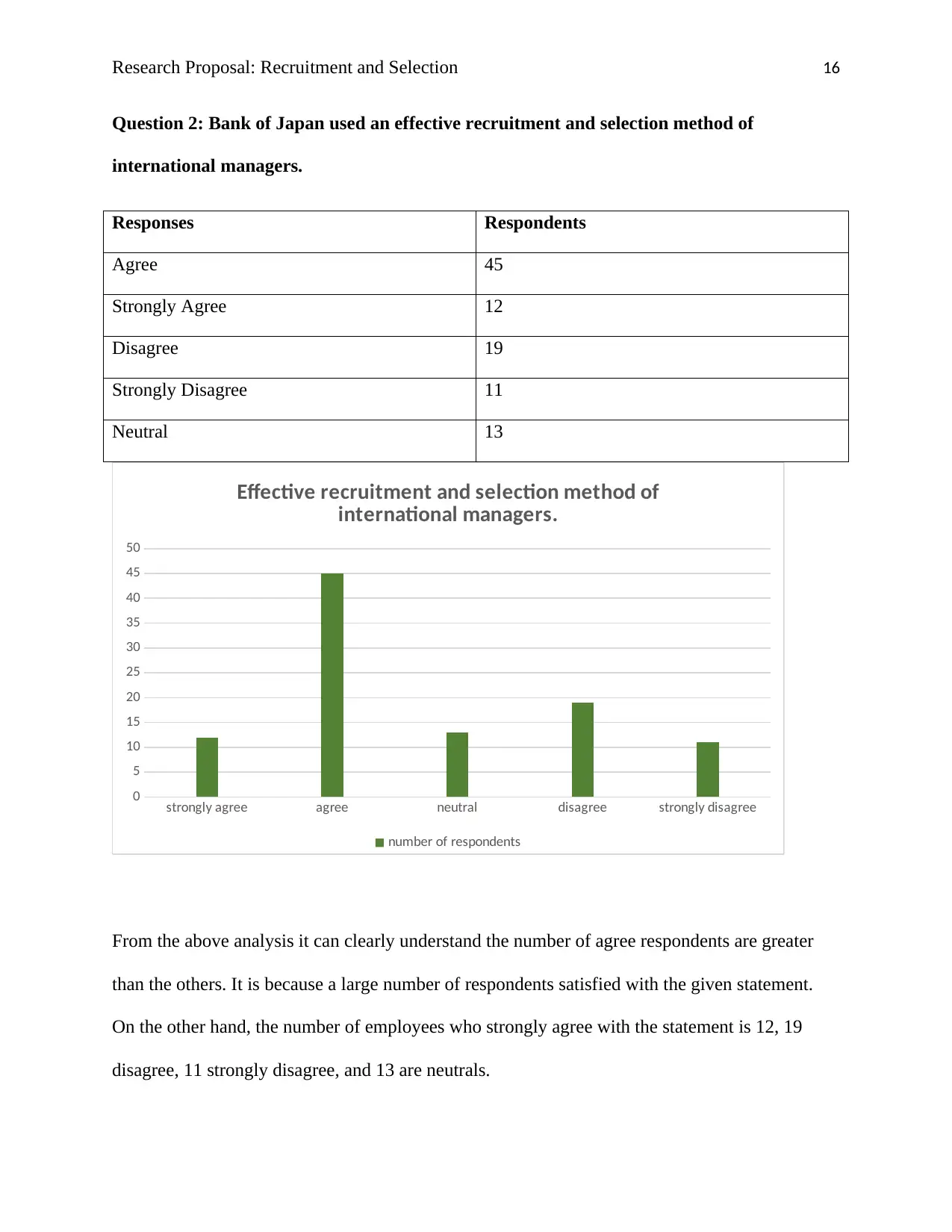
Research Proposal: Recruitment and Selection 16
Question 2: Bank of Japan used an effective recruitment and selection method of
international managers.
Responses Respondents
Agree 45
Strongly Agree 12
Disagree 19
Strongly Disagree 11
Neutral 13
From the above analysis it can clearly understand the number of agree respondents are greater
than the others. It is because a large number of respondents satisfied with the given statement.
On the other hand, the number of employees who strongly agree with the statement is 12, 19
disagree, 11 strongly disagree, and 13 are neutrals.
strongly agree agree neutral disagree strongly disagree
0
5
10
15
20
25
30
35
40
45
50
Effective recruitment and selection method of
international managers.
number of respondents
Question 2: Bank of Japan used an effective recruitment and selection method of
international managers.
Responses Respondents
Agree 45
Strongly Agree 12
Disagree 19
Strongly Disagree 11
Neutral 13
From the above analysis it can clearly understand the number of agree respondents are greater
than the others. It is because a large number of respondents satisfied with the given statement.
On the other hand, the number of employees who strongly agree with the statement is 12, 19
disagree, 11 strongly disagree, and 13 are neutrals.
strongly agree agree neutral disagree strongly disagree
0
5
10
15
20
25
30
35
40
45
50
Effective recruitment and selection method of
international managers.
number of respondents
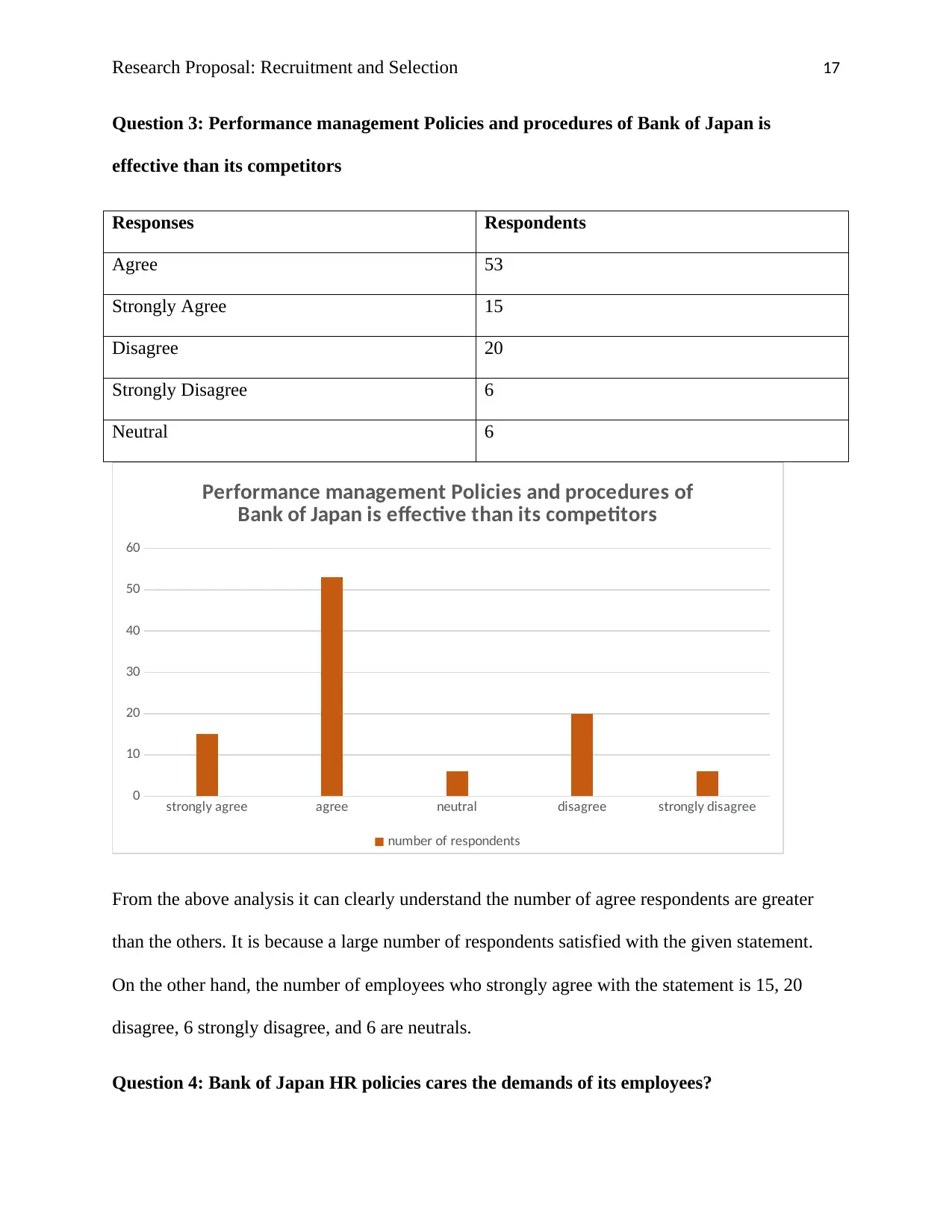
Research Proposal: Recruitment and Selection 17
Question 3: Performance management Policies and procedures of Bank of Japan is
effective than its competitors
Responses Respondents
Agree 53
Strongly Agree 15
Disagree 20
Strongly Disagree 6
Neutral 6
strongly agree agree neutral disagree strongly disagree
0
10
20
30
40
50
60
Performance management Policies and procedures of
Bank of Japan is effective than its competitors
number of respondents
From the above analysis it can clearly understand the number of agree respondents are greater
than the others. It is because a large number of respondents satisfied with the given statement.
On the other hand, the number of employees who strongly agree with the statement is 15, 20
disagree, 6 strongly disagree, and 6 are neutrals.
Question 4: Bank of Japan HR policies cares the demands of its employees?
Question 3: Performance management Policies and procedures of Bank of Japan is
effective than its competitors
Responses Respondents
Agree 53
Strongly Agree 15
Disagree 20
Strongly Disagree 6
Neutral 6
strongly agree agree neutral disagree strongly disagree
0
10
20
30
40
50
60
Performance management Policies and procedures of
Bank of Japan is effective than its competitors
number of respondents
From the above analysis it can clearly understand the number of agree respondents are greater
than the others. It is because a large number of respondents satisfied with the given statement.
On the other hand, the number of employees who strongly agree with the statement is 15, 20
disagree, 6 strongly disagree, and 6 are neutrals.
Question 4: Bank of Japan HR policies cares the demands of its employees?
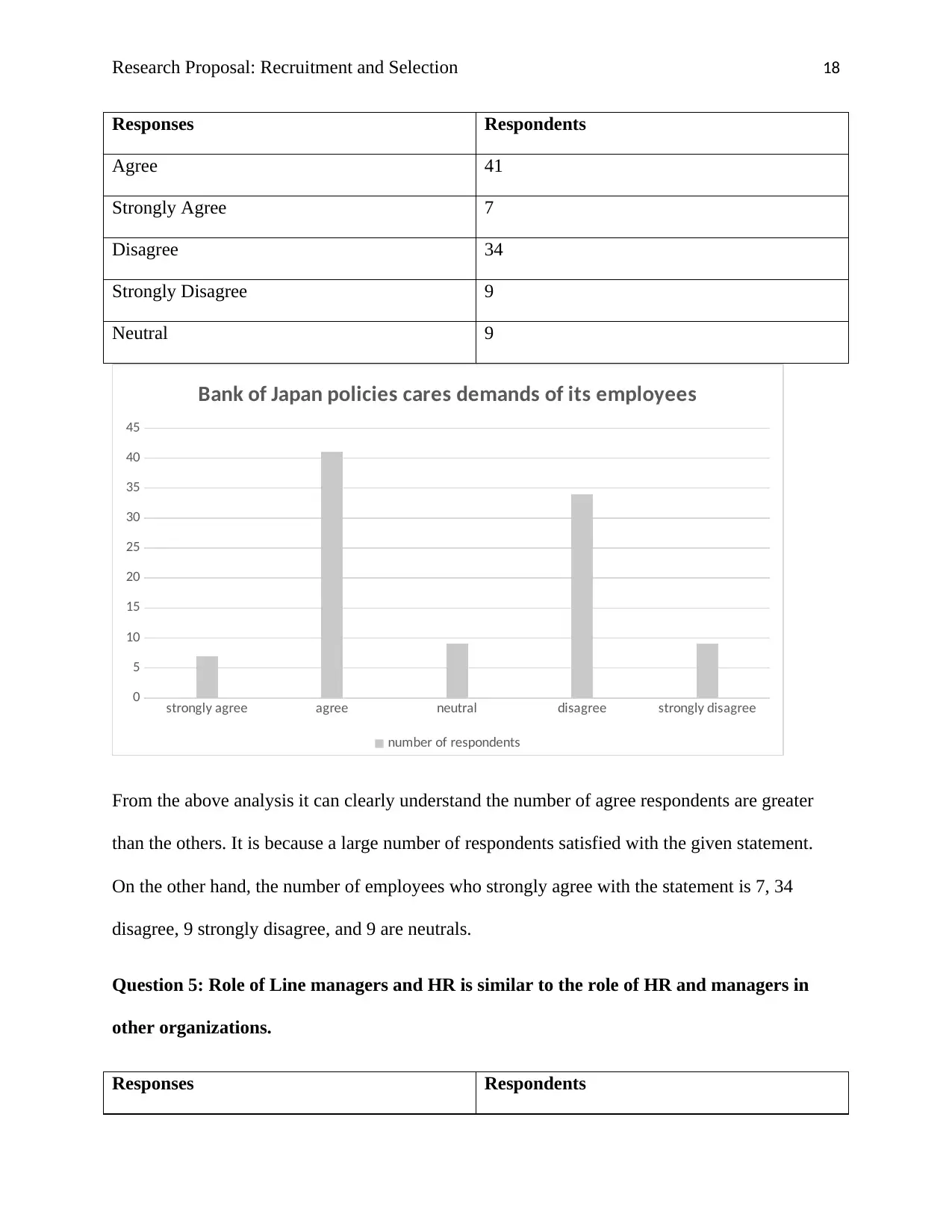
Research Proposal: Recruitment and Selection 18
Responses Respondents
Agree 41
Strongly Agree 7
Disagree 34
Strongly Disagree 9
Neutral 9
strongly agree agree neutral disagree strongly disagree
0
5
10
15
20
25
30
35
40
45
Bank of Japan policies cares demands of its employees
number of respondents
From the above analysis it can clearly understand the number of agree respondents are greater
than the others. It is because a large number of respondents satisfied with the given statement.
On the other hand, the number of employees who strongly agree with the statement is 7, 34
disagree, 9 strongly disagree, and 9 are neutrals.
Question 5: Role of Line managers and HR is similar to the role of HR and managers in
other organizations.
Responses Respondents
Responses Respondents
Agree 41
Strongly Agree 7
Disagree 34
Strongly Disagree 9
Neutral 9
strongly agree agree neutral disagree strongly disagree
0
5
10
15
20
25
30
35
40
45
Bank of Japan policies cares demands of its employees
number of respondents
From the above analysis it can clearly understand the number of agree respondents are greater
than the others. It is because a large number of respondents satisfied with the given statement.
On the other hand, the number of employees who strongly agree with the statement is 7, 34
disagree, 9 strongly disagree, and 9 are neutrals.
Question 5: Role of Line managers and HR is similar to the role of HR and managers in
other organizations.
Responses Respondents
Secure Best Marks with AI Grader
Need help grading? Try our AI Grader for instant feedback on your assignments.

Research Proposal: Recruitment and Selection 19
Agree 57
Strongly Agree 24
Disagree 14
Strongly Disagree 0
Neutral 5
strongly agree agree neutral disagree strongly disagree
0
10
20
30
40
50
60
Role of HR and line managers similar to others
number of respondents
From the above analysis, it can clearly understand the number of agree respondents are greater
than the others. It is because a large number of respondents satisfied with the given statement.
On the other hand, the number of employees who strongly agree with the statement is 24, 14
disagree, 0 strongly disagree, and 5 are neutrals.
Question 6: HR and line managers play an effective role in the formation of Bank of Japan
processes.
Responses Respondents
Agree 46
Agree 57
Strongly Agree 24
Disagree 14
Strongly Disagree 0
Neutral 5
strongly agree agree neutral disagree strongly disagree
0
10
20
30
40
50
60
Role of HR and line managers similar to others
number of respondents
From the above analysis, it can clearly understand the number of agree respondents are greater
than the others. It is because a large number of respondents satisfied with the given statement.
On the other hand, the number of employees who strongly agree with the statement is 24, 14
disagree, 0 strongly disagree, and 5 are neutrals.
Question 6: HR and line managers play an effective role in the formation of Bank of Japan
processes.
Responses Respondents
Agree 46
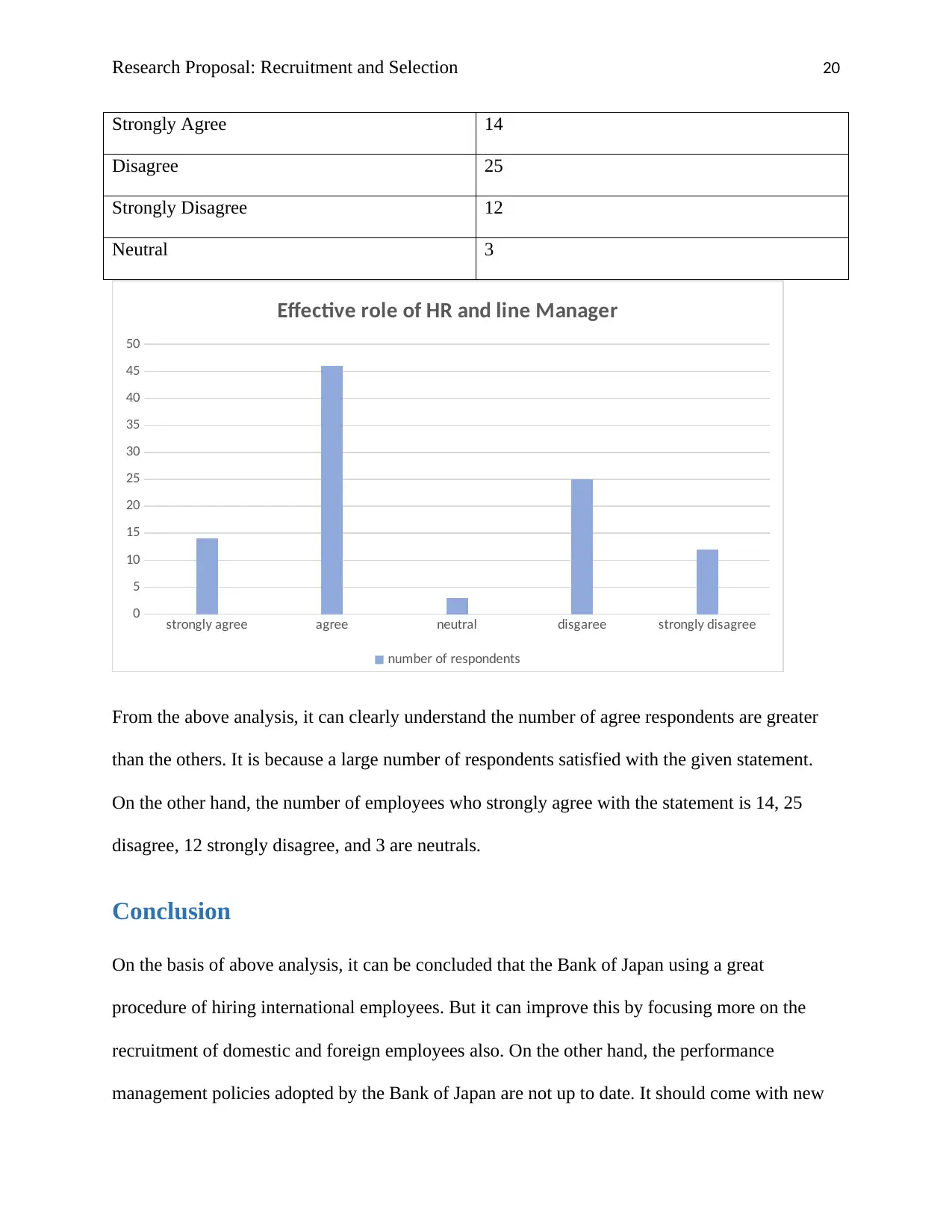
Research Proposal: Recruitment and Selection 20
Strongly Agree 14
Disagree 25
Strongly Disagree 12
Neutral 3
strongly agree agree neutral disgaree strongly disagree
0
5
10
15
20
25
30
35
40
45
50
Effective role of HR and line Manager
number of respondents
From the above analysis, it can clearly understand the number of agree respondents are greater
than the others. It is because a large number of respondents satisfied with the given statement.
On the other hand, the number of employees who strongly agree with the statement is 14, 25
disagree, 12 strongly disagree, and 3 are neutrals.
Conclusion
On the basis of above analysis, it can be concluded that the Bank of Japan using a great
procedure of hiring international employees. But it can improve this by focusing more on the
recruitment of domestic and foreign employees also. On the other hand, the performance
management policies adopted by the Bank of Japan are not up to date. It should come with new
Strongly Agree 14
Disagree 25
Strongly Disagree 12
Neutral 3
strongly agree agree neutral disgaree strongly disagree
0
5
10
15
20
25
30
35
40
45
50
Effective role of HR and line Manager
number of respondents
From the above analysis, it can clearly understand the number of agree respondents are greater
than the others. It is because a large number of respondents satisfied with the given statement.
On the other hand, the number of employees who strongly agree with the statement is 14, 25
disagree, 12 strongly disagree, and 3 are neutrals.
Conclusion
On the basis of above analysis, it can be concluded that the Bank of Japan using a great
procedure of hiring international employees. But it can improve this by focusing more on the
recruitment of domestic and foreign employees also. On the other hand, the performance
management policies adopted by the Bank of Japan are not up to date. It should come with new
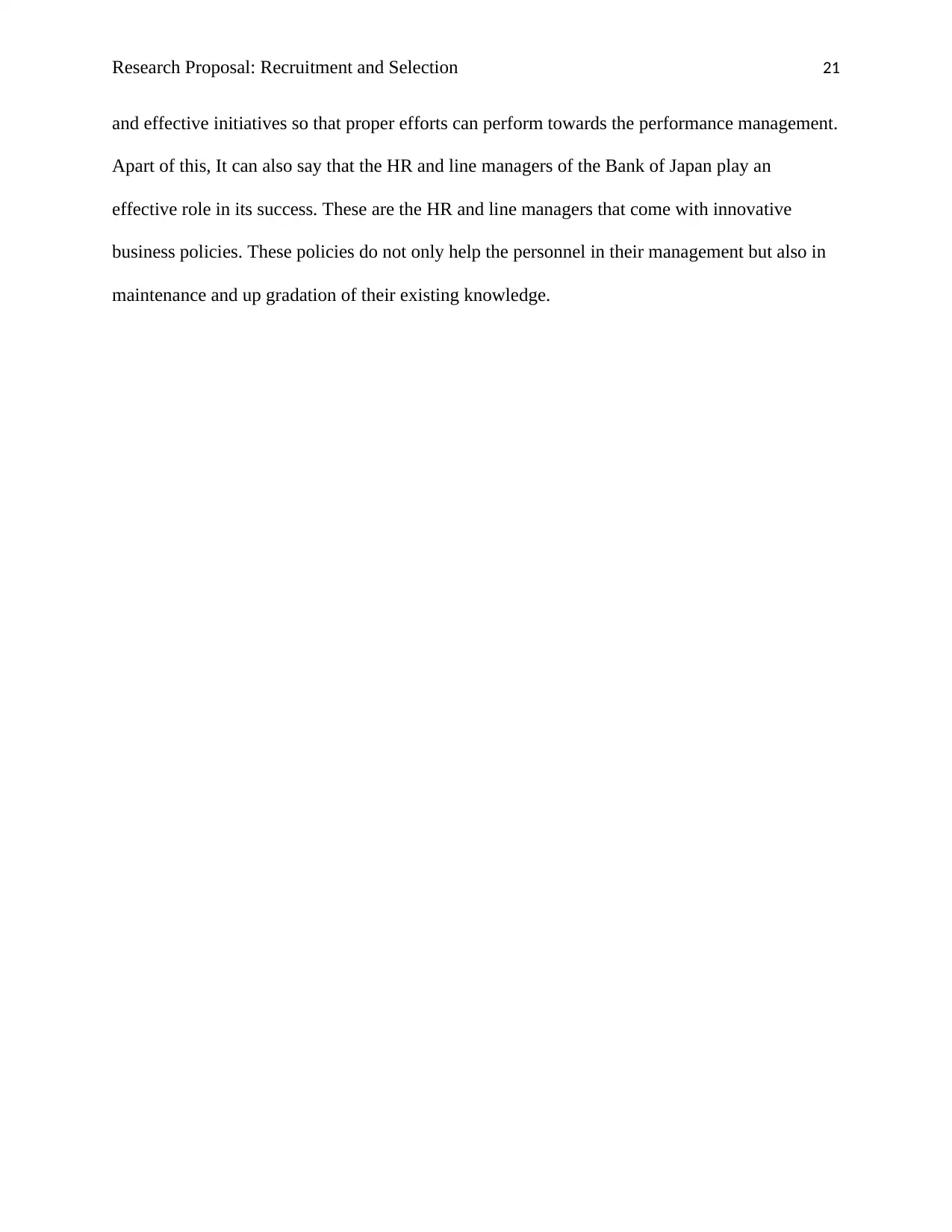
Research Proposal: Recruitment and Selection 21
and effective initiatives so that proper efforts can perform towards the performance management.
Apart of this, It can also say that the HR and line managers of the Bank of Japan play an
effective role in its success. These are the HR and line managers that come with innovative
business policies. These policies do not only help the personnel in their management but also in
maintenance and up gradation of their existing knowledge.
and effective initiatives so that proper efforts can perform towards the performance management.
Apart of this, It can also say that the HR and line managers of the Bank of Japan play an
effective role in its success. These are the HR and line managers that come with innovative
business policies. These policies do not only help the personnel in their management but also in
maintenance and up gradation of their existing knowledge.
Paraphrase This Document
Need a fresh take? Get an instant paraphrase of this document with our AI Paraphraser
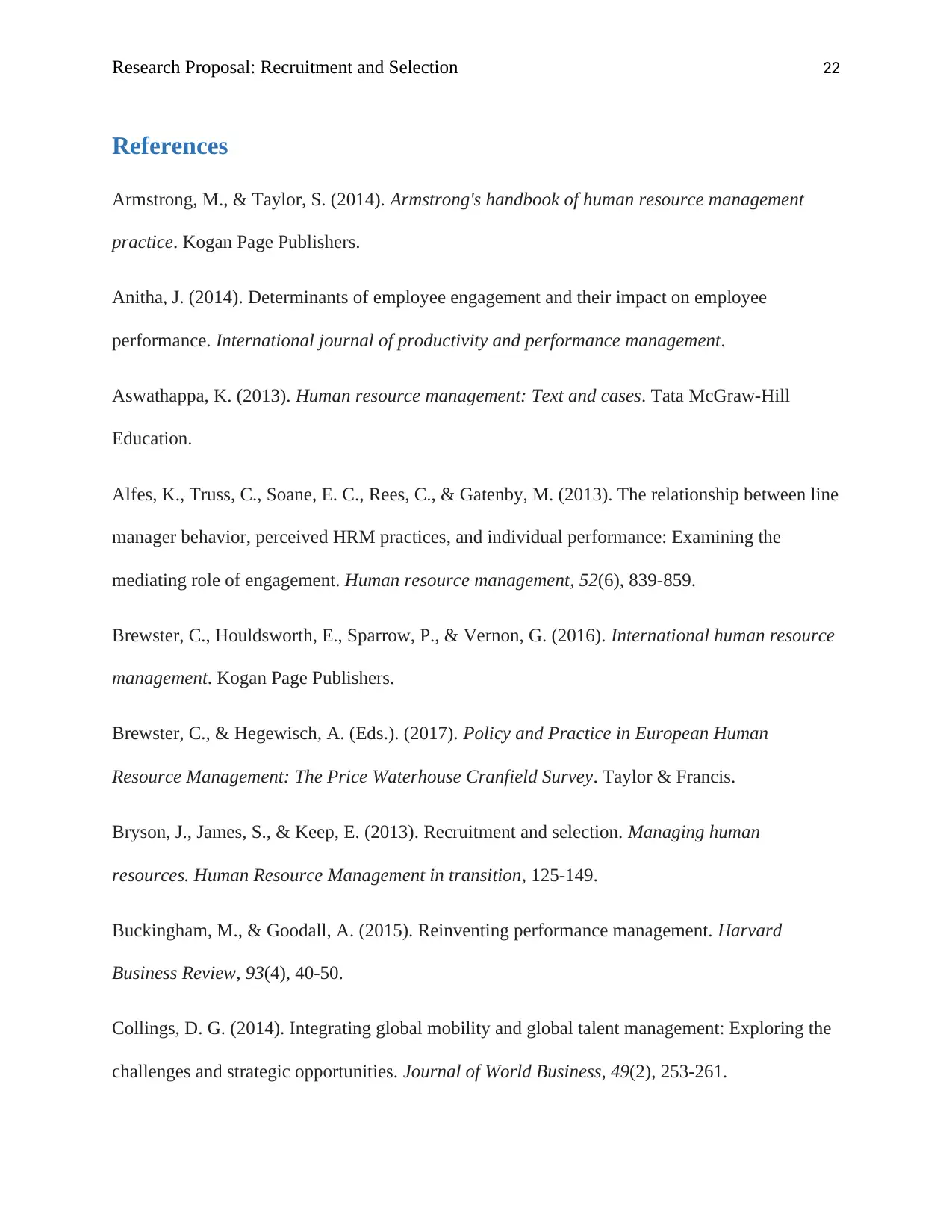
Research Proposal: Recruitment and Selection 22
References
Armstrong, M., & Taylor, S. (2014). Armstrong's handbook of human resource management
practice. Kogan Page Publishers.
Anitha, J. (2014). Determinants of employee engagement and their impact on employee
performance. International journal of productivity and performance management.
Aswathappa, K. (2013). Human resource management: Text and cases. Tata McGraw-Hill
Education.
Alfes, K., Truss, C., Soane, E. C., Rees, C., & Gatenby, M. (2013). The relationship between line
manager behavior, perceived HRM practices, and individual performance: Examining the
mediating role of engagement. Human resource management, 52(6), 839-859.
Brewster, C., Houldsworth, E., Sparrow, P., & Vernon, G. (2016). International human resource
management. Kogan Page Publishers.
Brewster, C., & Hegewisch, A. (Eds.). (2017). Policy and Practice in European Human
Resource Management: The Price Waterhouse Cranfield Survey. Taylor & Francis.
Bryson, J., James, S., & Keep, E. (2013). Recruitment and selection. Managing human
resources. Human Resource Management in transition, 125-149.
Buckingham, M., & Goodall, A. (2015). Reinventing performance management. Harvard
Business Review, 93(4), 40-50.
Collings, D. G. (2014). Integrating global mobility and global talent management: Exploring the
challenges and strategic opportunities. Journal of World Business, 49(2), 253-261.
References
Armstrong, M., & Taylor, S. (2014). Armstrong's handbook of human resource management
practice. Kogan Page Publishers.
Anitha, J. (2014). Determinants of employee engagement and their impact on employee
performance. International journal of productivity and performance management.
Aswathappa, K. (2013). Human resource management: Text and cases. Tata McGraw-Hill
Education.
Alfes, K., Truss, C., Soane, E. C., Rees, C., & Gatenby, M. (2013). The relationship between line
manager behavior, perceived HRM practices, and individual performance: Examining the
mediating role of engagement. Human resource management, 52(6), 839-859.
Brewster, C., Houldsworth, E., Sparrow, P., & Vernon, G. (2016). International human resource
management. Kogan Page Publishers.
Brewster, C., & Hegewisch, A. (Eds.). (2017). Policy and Practice in European Human
Resource Management: The Price Waterhouse Cranfield Survey. Taylor & Francis.
Bryson, J., James, S., & Keep, E. (2013). Recruitment and selection. Managing human
resources. Human Resource Management in transition, 125-149.
Buckingham, M., & Goodall, A. (2015). Reinventing performance management. Harvard
Business Review, 93(4), 40-50.
Collings, D. G. (2014). Integrating global mobility and global talent management: Exploring the
challenges and strategic opportunities. Journal of World Business, 49(2), 253-261.
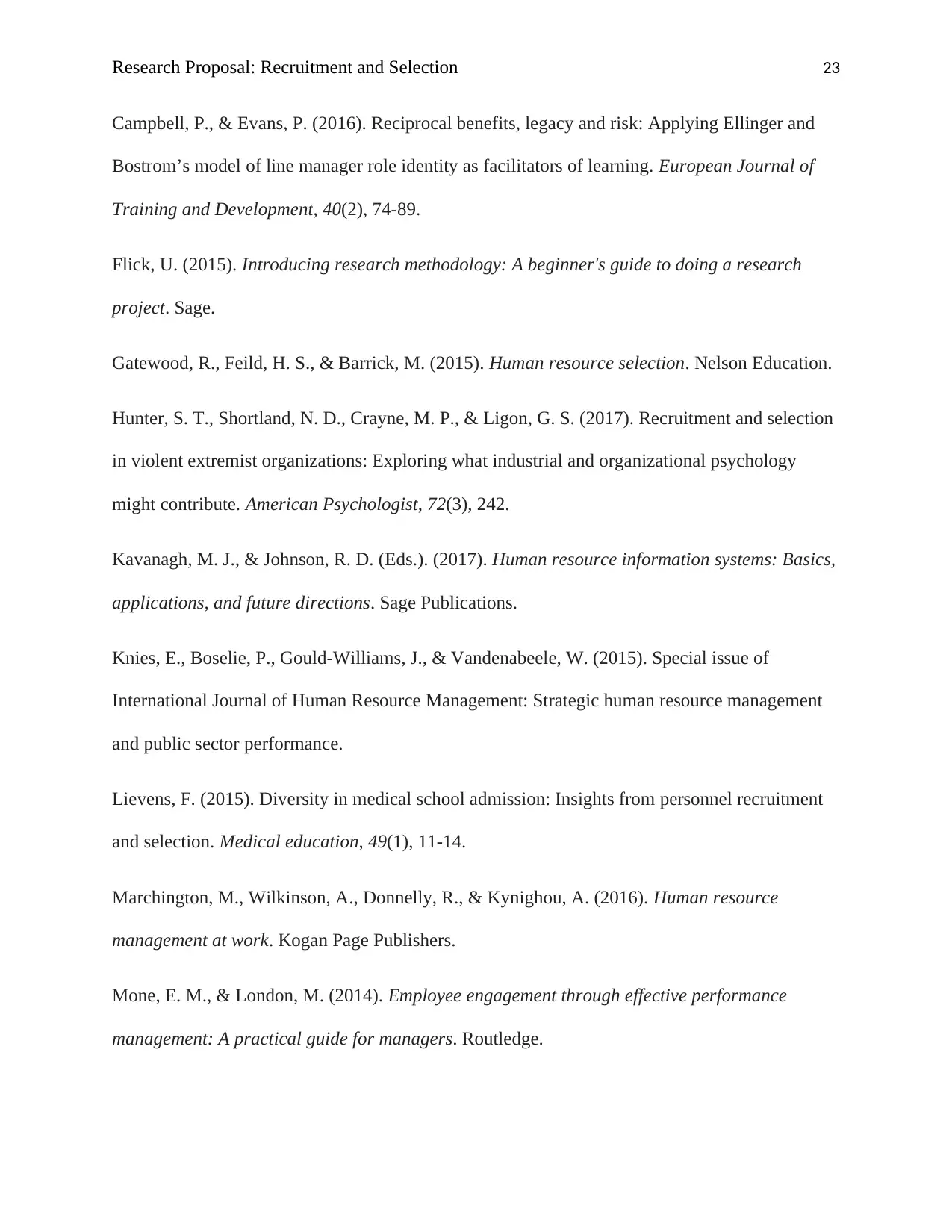
Research Proposal: Recruitment and Selection 23
Campbell, P., & Evans, P. (2016). Reciprocal benefits, legacy and risk: Applying Ellinger and
Bostrom’s model of line manager role identity as facilitators of learning. European Journal of
Training and Development, 40(2), 74-89.
Flick, U. (2015). Introducing research methodology: A beginner's guide to doing a research
project. Sage.
Gatewood, R., Feild, H. S., & Barrick, M. (2015). Human resource selection. Nelson Education.
Hunter, S. T., Shortland, N. D., Crayne, M. P., & Ligon, G. S. (2017). Recruitment and selection
in violent extremist organizations: Exploring what industrial and organizational psychology
might contribute. American Psychologist, 72(3), 242.
Kavanagh, M. J., & Johnson, R. D. (Eds.). (2017). Human resource information systems: Basics,
applications, and future directions. Sage Publications.
Knies, E., Boselie, P., Gould-Williams, J., & Vandenabeele, W. (2015). Special issue of
International Journal of Human Resource Management: Strategic human resource management
and public sector performance.
Lievens, F. (2015). Diversity in medical school admission: Insights from personnel recruitment
and selection. Medical education, 49(1), 11-14.
Marchington, M., Wilkinson, A., Donnelly, R., & Kynighou, A. (2016). Human resource
management at work. Kogan Page Publishers.
Mone, E. M., & London, M. (2014). Employee engagement through effective performance
management: A practical guide for managers. Routledge.
Campbell, P., & Evans, P. (2016). Reciprocal benefits, legacy and risk: Applying Ellinger and
Bostrom’s model of line manager role identity as facilitators of learning. European Journal of
Training and Development, 40(2), 74-89.
Flick, U. (2015). Introducing research methodology: A beginner's guide to doing a research
project. Sage.
Gatewood, R., Feild, H. S., & Barrick, M. (2015). Human resource selection. Nelson Education.
Hunter, S. T., Shortland, N. D., Crayne, M. P., & Ligon, G. S. (2017). Recruitment and selection
in violent extremist organizations: Exploring what industrial and organizational psychology
might contribute. American Psychologist, 72(3), 242.
Kavanagh, M. J., & Johnson, R. D. (Eds.). (2017). Human resource information systems: Basics,
applications, and future directions. Sage Publications.
Knies, E., Boselie, P., Gould-Williams, J., & Vandenabeele, W. (2015). Special issue of
International Journal of Human Resource Management: Strategic human resource management
and public sector performance.
Lievens, F. (2015). Diversity in medical school admission: Insights from personnel recruitment
and selection. Medical education, 49(1), 11-14.
Marchington, M., Wilkinson, A., Donnelly, R., & Kynighou, A. (2016). Human resource
management at work. Kogan Page Publishers.
Mone, E. M., & London, M. (2014). Employee engagement through effective performance
management: A practical guide for managers. Routledge.
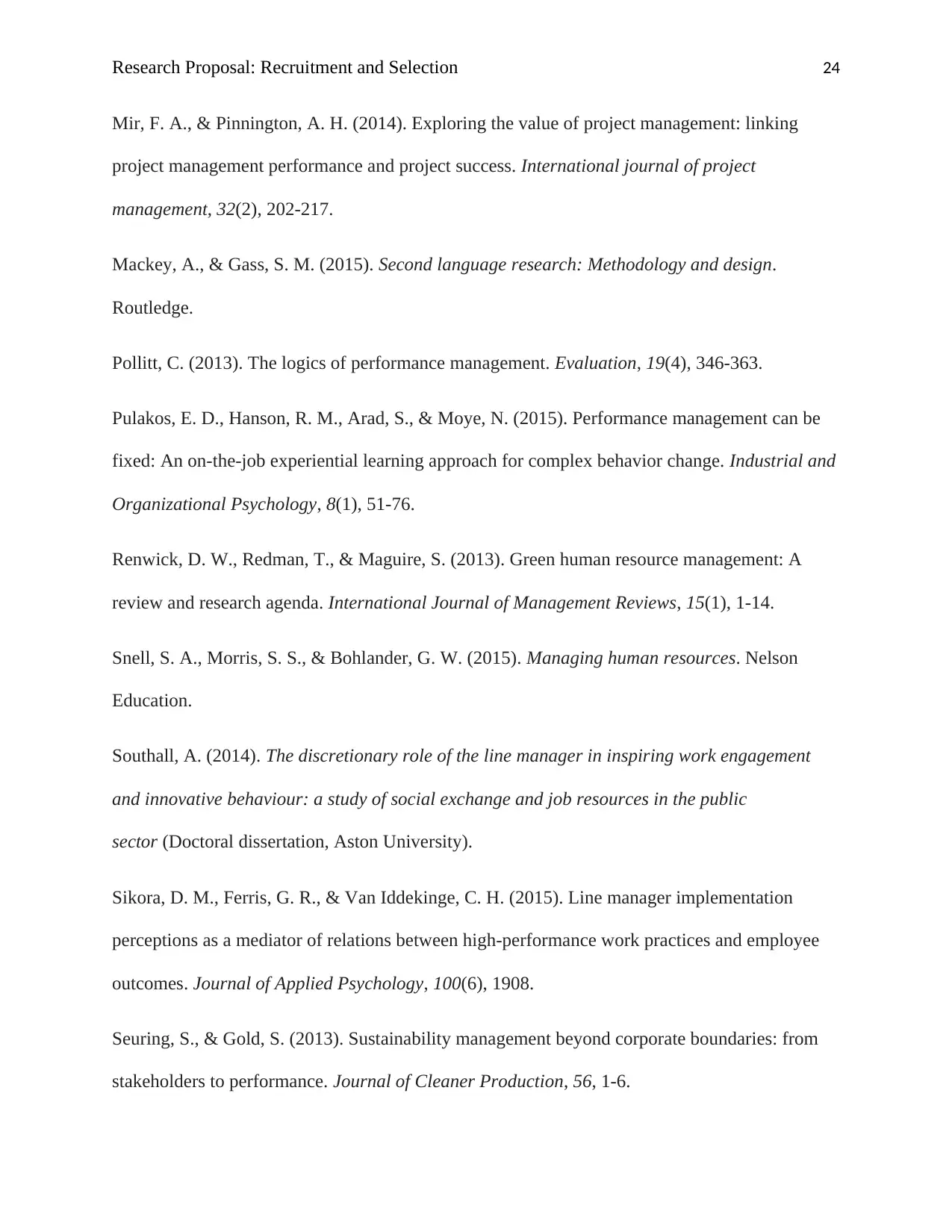
Research Proposal: Recruitment and Selection 24
Mir, F. A., & Pinnington, A. H. (2014). Exploring the value of project management: linking
project management performance and project success. International journal of project
management, 32(2), 202-217.
Mackey, A., & Gass, S. M. (2015). Second language research: Methodology and design.
Routledge.
Pollitt, C. (2013). The logics of performance management. Evaluation, 19(4), 346-363.
Pulakos, E. D., Hanson, R. M., Arad, S., & Moye, N. (2015). Performance management can be
fixed: An on-the-job experiential learning approach for complex behavior change. Industrial and
Organizational Psychology, 8(1), 51-76.
Renwick, D. W., Redman, T., & Maguire, S. (2013). Green human resource management: A
review and research agenda. International Journal of Management Reviews, 15(1), 1-14.
Snell, S. A., Morris, S. S., & Bohlander, G. W. (2015). Managing human resources. Nelson
Education.
Southall, A. (2014). The discretionary role of the line manager in inspiring work engagement
and innovative behaviour: a study of social exchange and job resources in the public
sector (Doctoral dissertation, Aston University).
Sikora, D. M., Ferris, G. R., & Van Iddekinge, C. H. (2015). Line manager implementation
perceptions as a mediator of relations between high-performance work practices and employee
outcomes. Journal of Applied Psychology, 100(6), 1908.
Seuring, S., & Gold, S. (2013). Sustainability management beyond corporate boundaries: from
stakeholders to performance. Journal of Cleaner Production, 56, 1-6.
Mir, F. A., & Pinnington, A. H. (2014). Exploring the value of project management: linking
project management performance and project success. International journal of project
management, 32(2), 202-217.
Mackey, A., & Gass, S. M. (2015). Second language research: Methodology and design.
Routledge.
Pollitt, C. (2013). The logics of performance management. Evaluation, 19(4), 346-363.
Pulakos, E. D., Hanson, R. M., Arad, S., & Moye, N. (2015). Performance management can be
fixed: An on-the-job experiential learning approach for complex behavior change. Industrial and
Organizational Psychology, 8(1), 51-76.
Renwick, D. W., Redman, T., & Maguire, S. (2013). Green human resource management: A
review and research agenda. International Journal of Management Reviews, 15(1), 1-14.
Snell, S. A., Morris, S. S., & Bohlander, G. W. (2015). Managing human resources. Nelson
Education.
Southall, A. (2014). The discretionary role of the line manager in inspiring work engagement
and innovative behaviour: a study of social exchange and job resources in the public
sector (Doctoral dissertation, Aston University).
Sikora, D. M., Ferris, G. R., & Van Iddekinge, C. H. (2015). Line manager implementation
perceptions as a mediator of relations between high-performance work practices and employee
outcomes. Journal of Applied Psychology, 100(6), 1908.
Seuring, S., & Gold, S. (2013). Sustainability management beyond corporate boundaries: from
stakeholders to performance. Journal of Cleaner Production, 56, 1-6.
Secure Best Marks with AI Grader
Need help grading? Try our AI Grader for instant feedback on your assignments.
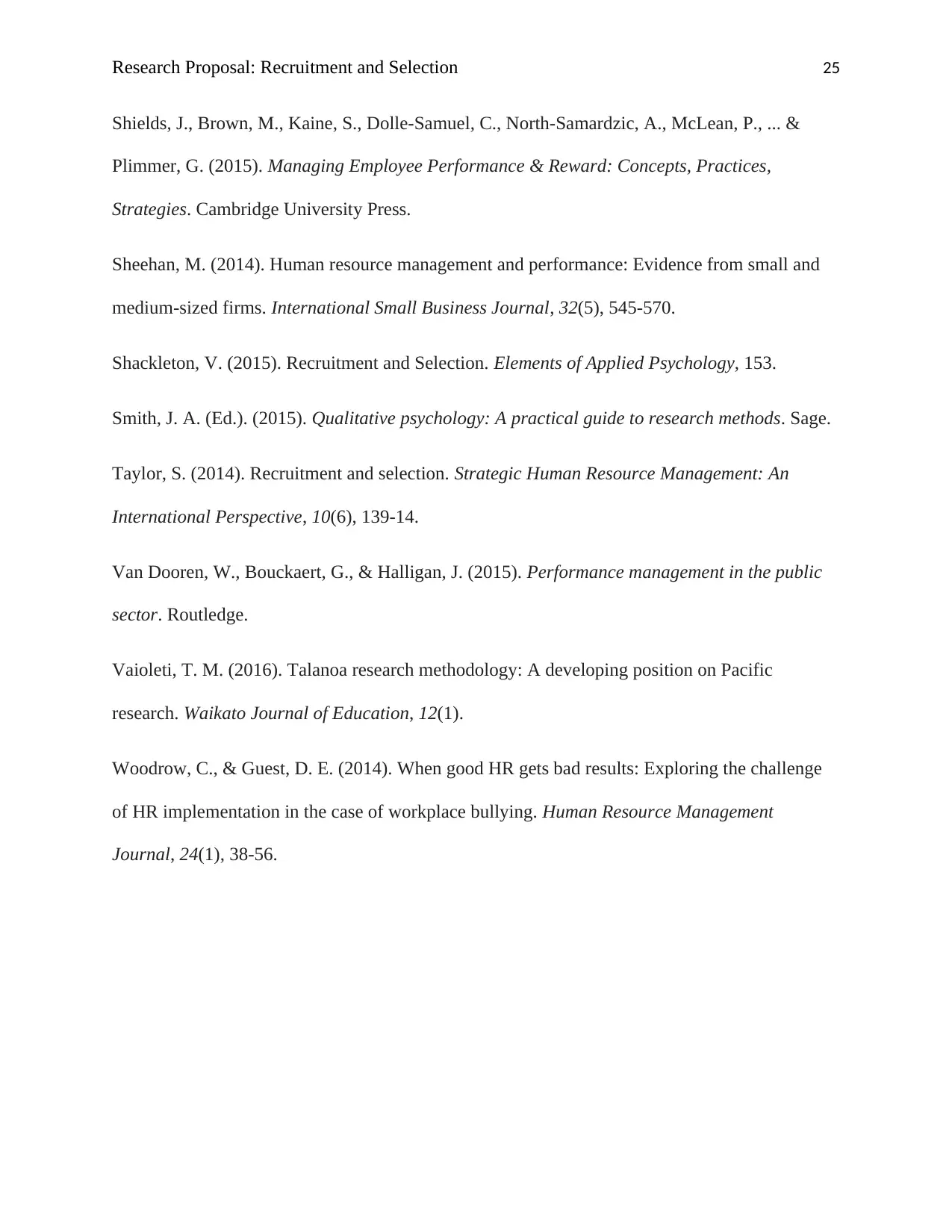
Research Proposal: Recruitment and Selection 25
Shields, J., Brown, M., Kaine, S., Dolle-Samuel, C., North-Samardzic, A., McLean, P., ... &
Plimmer, G. (2015). Managing Employee Performance & Reward: Concepts, Practices,
Strategies. Cambridge University Press.
Sheehan, M. (2014). Human resource management and performance: Evidence from small and
medium-sized firms. International Small Business Journal, 32(5), 545-570.
Shackleton, V. (2015). Recruitment and Selection. Elements of Applied Psychology, 153.
Smith, J. A. (Ed.). (2015). Qualitative psychology: A practical guide to research methods. Sage.
Taylor, S. (2014). Recruitment and selection. Strategic Human Resource Management: An
International Perspective, 10(6), 139-14.
Van Dooren, W., Bouckaert, G., & Halligan, J. (2015). Performance management in the public
sector. Routledge.
Vaioleti, T. M. (2016). Talanoa research methodology: A developing position on Pacific
research. Waikato Journal of Education, 12(1).
Woodrow, C., & Guest, D. E. (2014). When good HR gets bad results: Exploring the challenge
of HR implementation in the case of workplace bullying. Human Resource Management
Journal, 24(1), 38-56.
Shields, J., Brown, M., Kaine, S., Dolle-Samuel, C., North-Samardzic, A., McLean, P., ... &
Plimmer, G. (2015). Managing Employee Performance & Reward: Concepts, Practices,
Strategies. Cambridge University Press.
Sheehan, M. (2014). Human resource management and performance: Evidence from small and
medium-sized firms. International Small Business Journal, 32(5), 545-570.
Shackleton, V. (2015). Recruitment and Selection. Elements of Applied Psychology, 153.
Smith, J. A. (Ed.). (2015). Qualitative psychology: A practical guide to research methods. Sage.
Taylor, S. (2014). Recruitment and selection. Strategic Human Resource Management: An
International Perspective, 10(6), 139-14.
Van Dooren, W., Bouckaert, G., & Halligan, J. (2015). Performance management in the public
sector. Routledge.
Vaioleti, T. M. (2016). Talanoa research methodology: A developing position on Pacific
research. Waikato Journal of Education, 12(1).
Woodrow, C., & Guest, D. E. (2014). When good HR gets bad results: Exploring the challenge
of HR implementation in the case of workplace bullying. Human Resource Management
Journal, 24(1), 38-56.
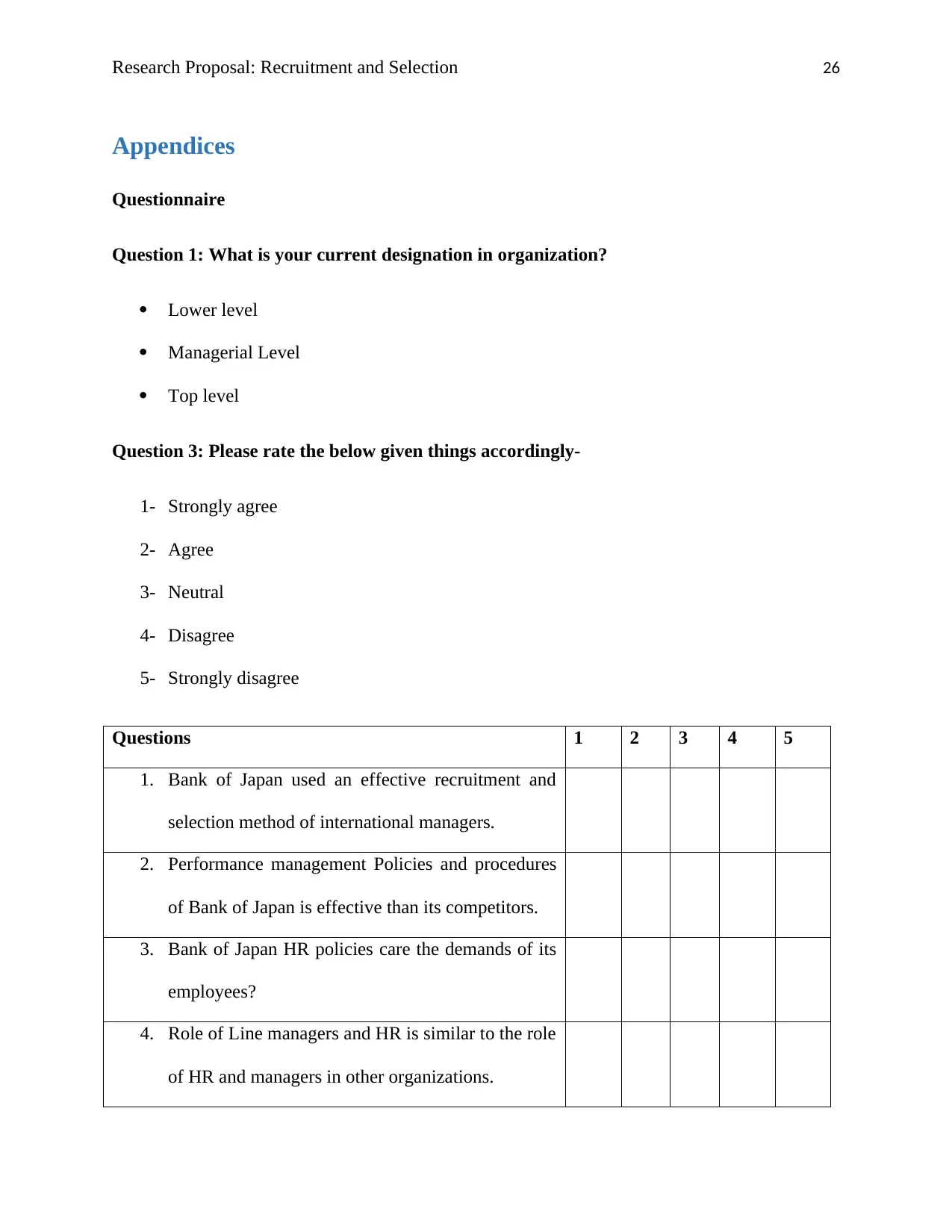
Research Proposal: Recruitment and Selection 26
Appendices
Questionnaire
Question 1: What is your current designation in organization?
Lower level
Managerial Level
Top level
Question 3: Please rate the below given things accordingly-
1- Strongly agree
2- Agree
3- Neutral
4- Disagree
5- Strongly disagree
Questions 1 2 3 4 5
1. Bank of Japan used an effective recruitment and
selection method of international managers.
2. Performance management Policies and procedures
of Bank of Japan is effective than its competitors.
3. Bank of Japan HR policies care the demands of its
employees?
4. Role of Line managers and HR is similar to the role
of HR and managers in other organizations.
Appendices
Questionnaire
Question 1: What is your current designation in organization?
Lower level
Managerial Level
Top level
Question 3: Please rate the below given things accordingly-
1- Strongly agree
2- Agree
3- Neutral
4- Disagree
5- Strongly disagree
Questions 1 2 3 4 5
1. Bank of Japan used an effective recruitment and
selection method of international managers.
2. Performance management Policies and procedures
of Bank of Japan is effective than its competitors.
3. Bank of Japan HR policies care the demands of its
employees?
4. Role of Line managers and HR is similar to the role
of HR and managers in other organizations.

Research Proposal: Recruitment and Selection 27
5. HR and line managers play an effective role in the
formation of Bank of Japan processes.
5. HR and line managers play an effective role in the
formation of Bank of Japan processes.
1 out of 28
Related Documents
Your All-in-One AI-Powered Toolkit for Academic Success.
+13062052269
info@desklib.com
Available 24*7 on WhatsApp / Email
![[object Object]](/_next/static/media/star-bottom.7253800d.svg)
Unlock your academic potential
© 2024 | Zucol Services PVT LTD | All rights reserved.





